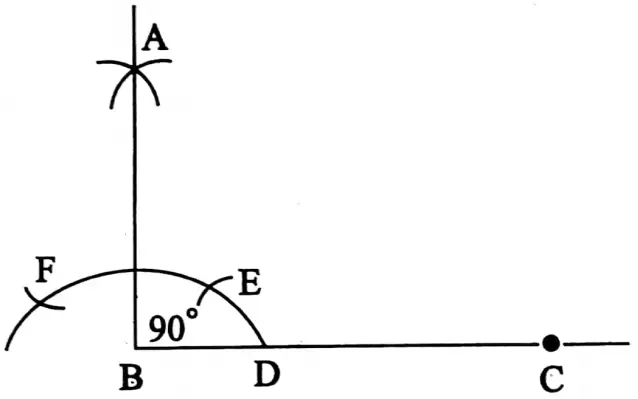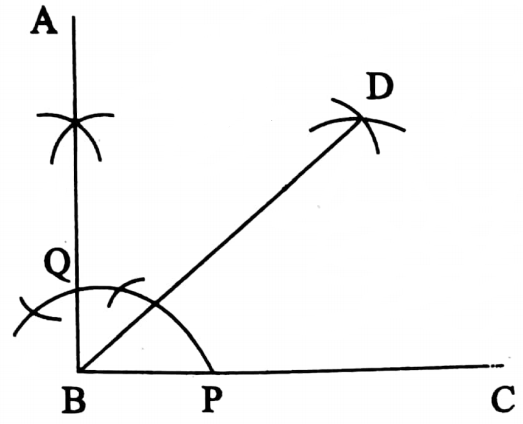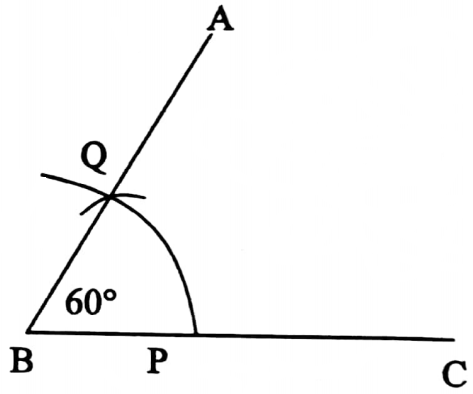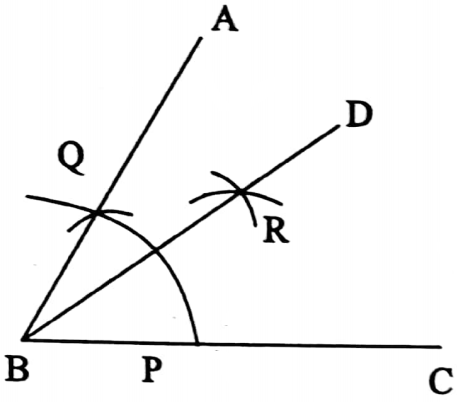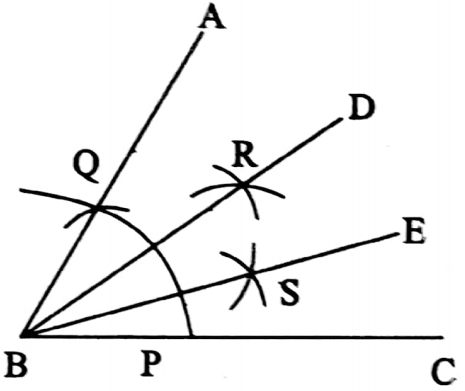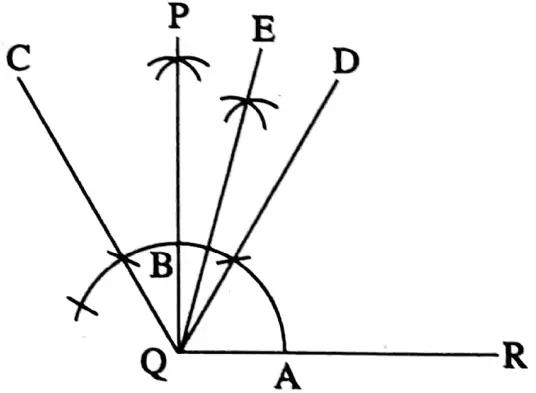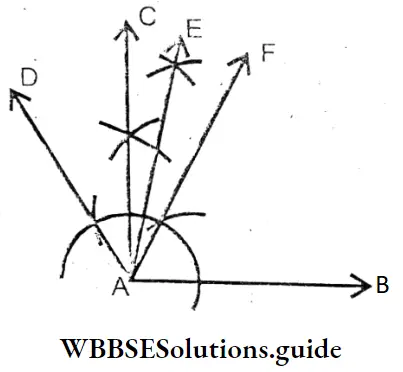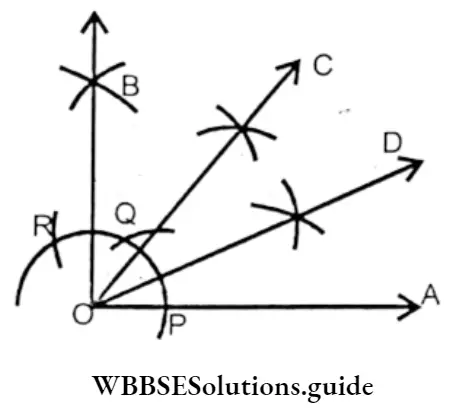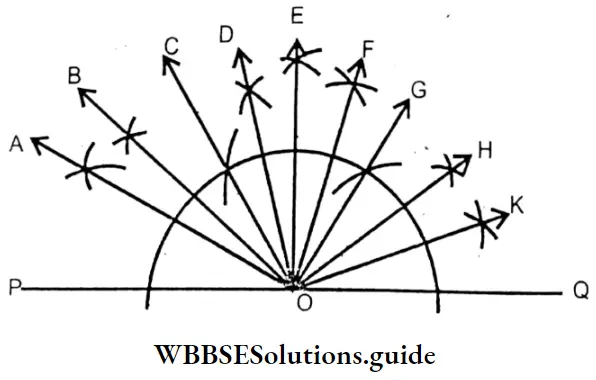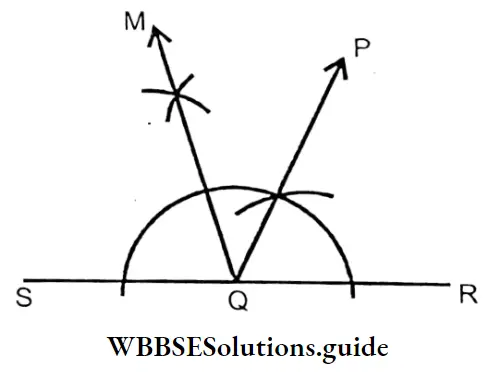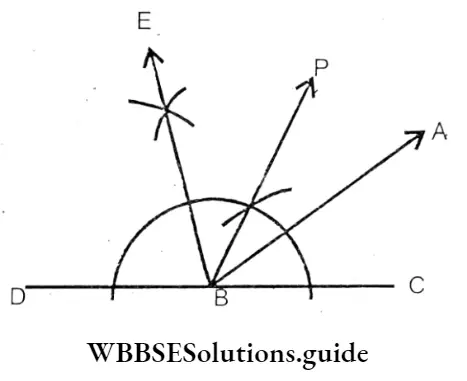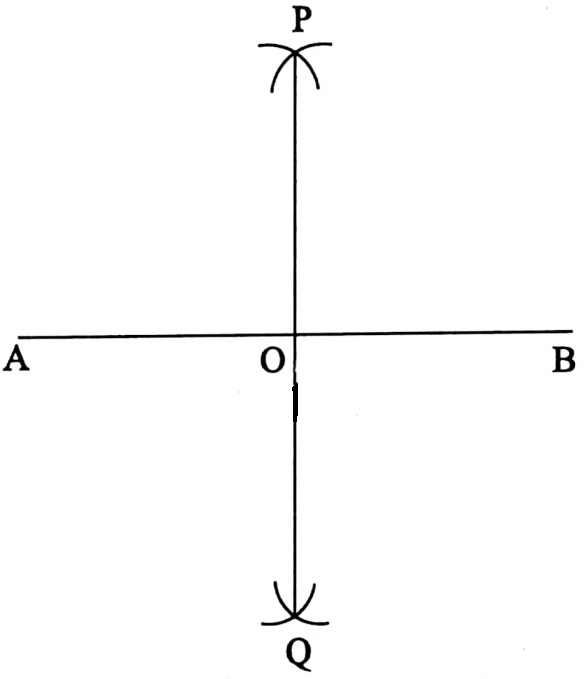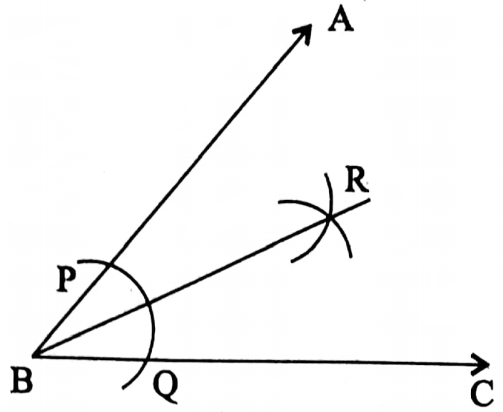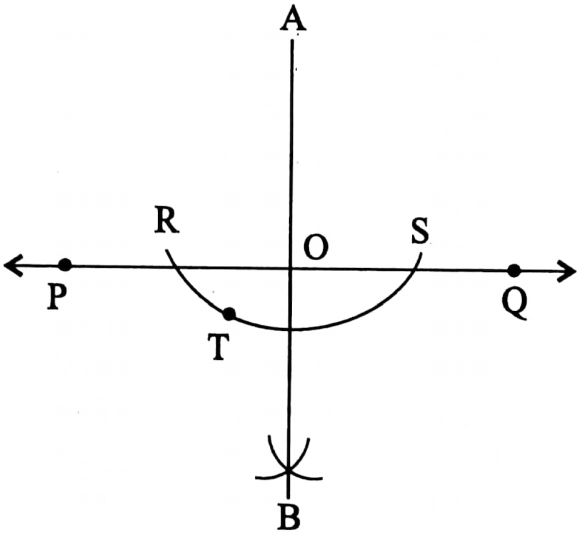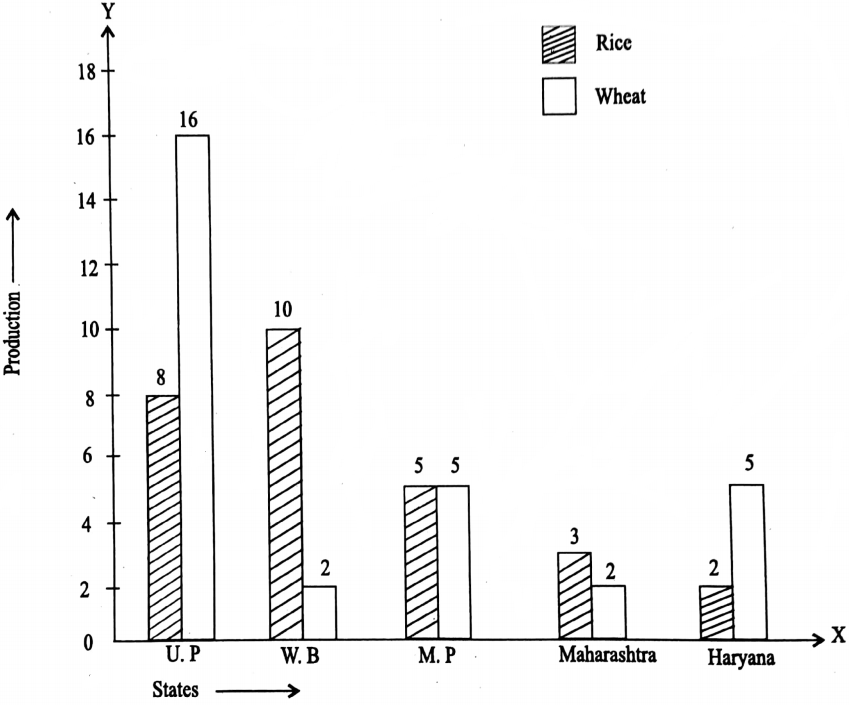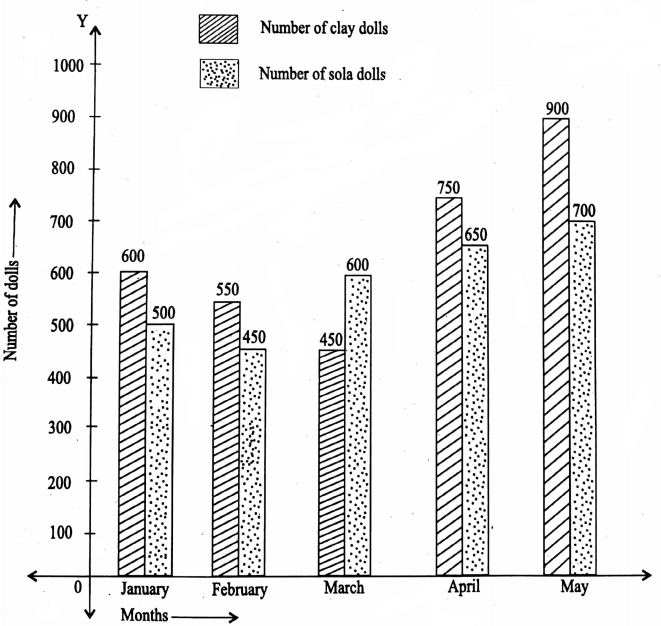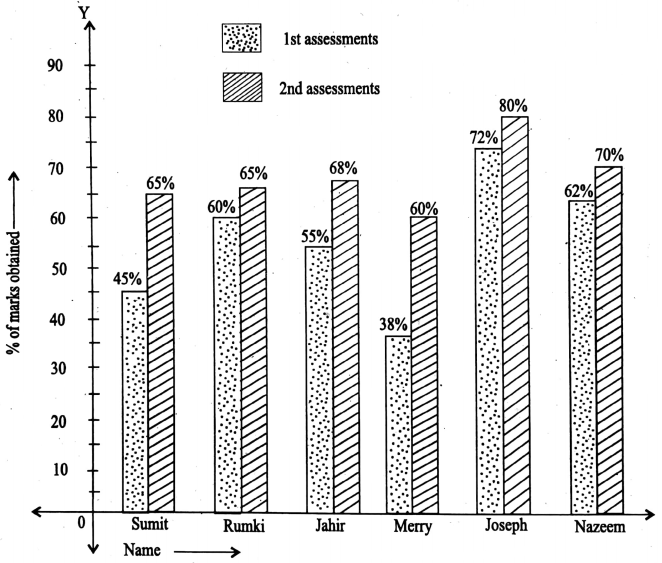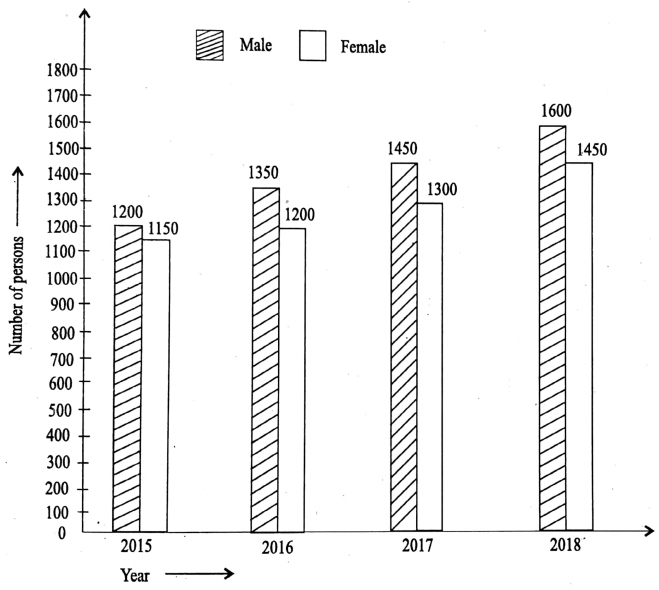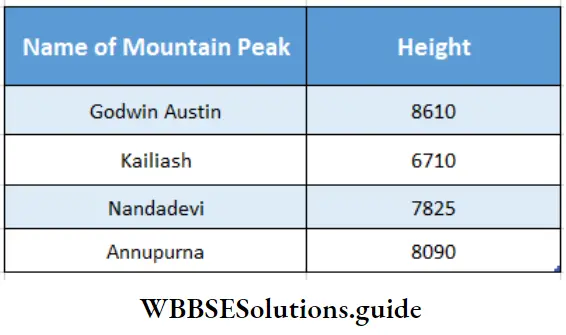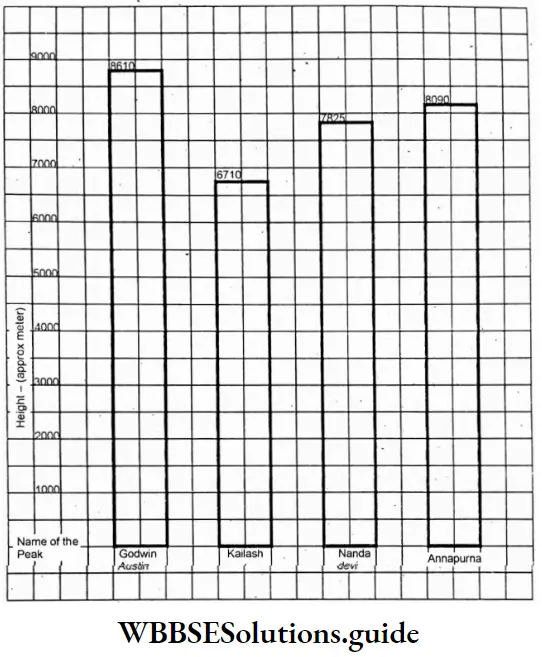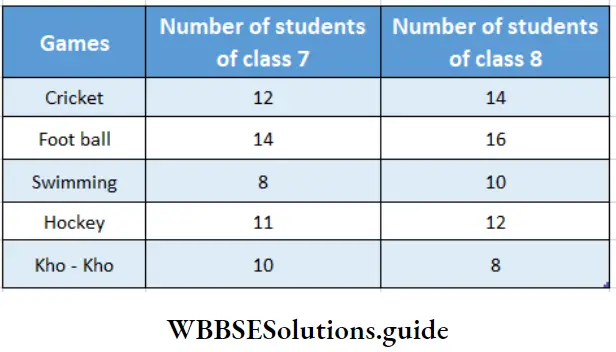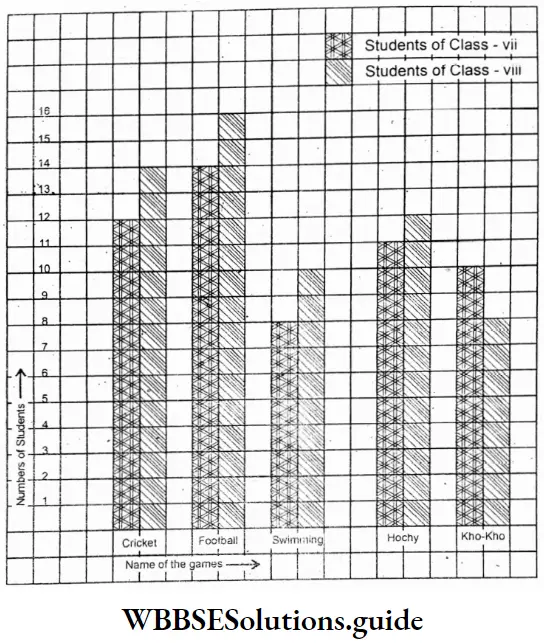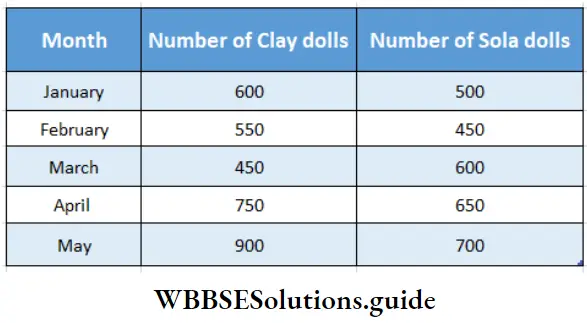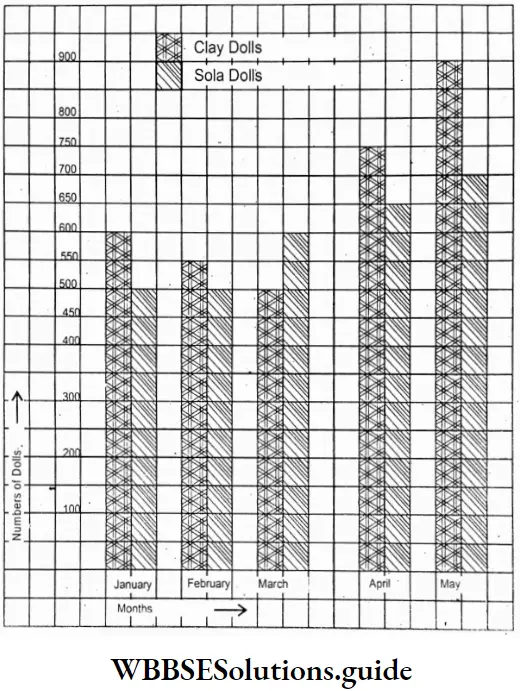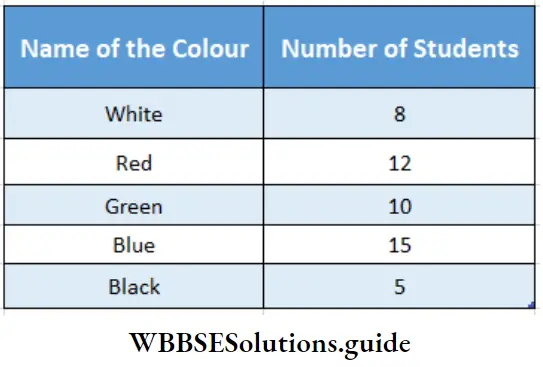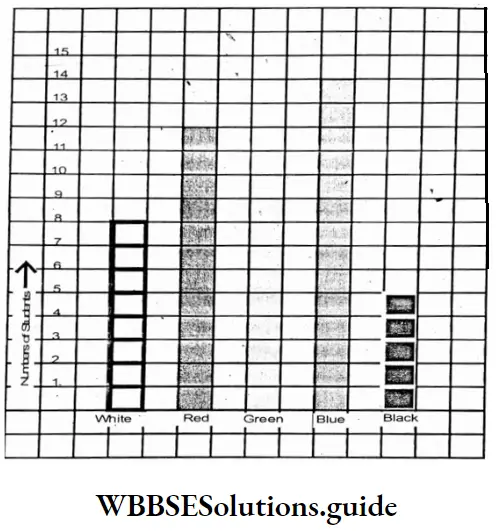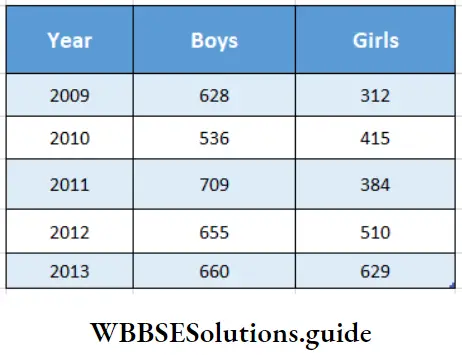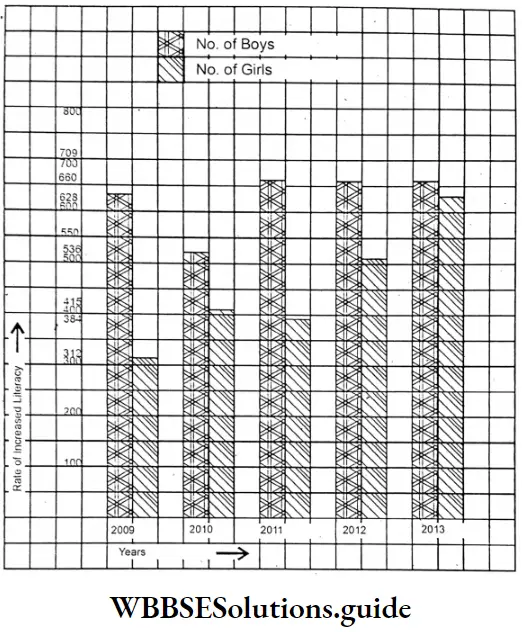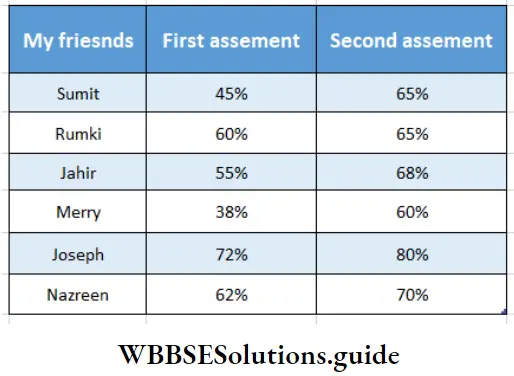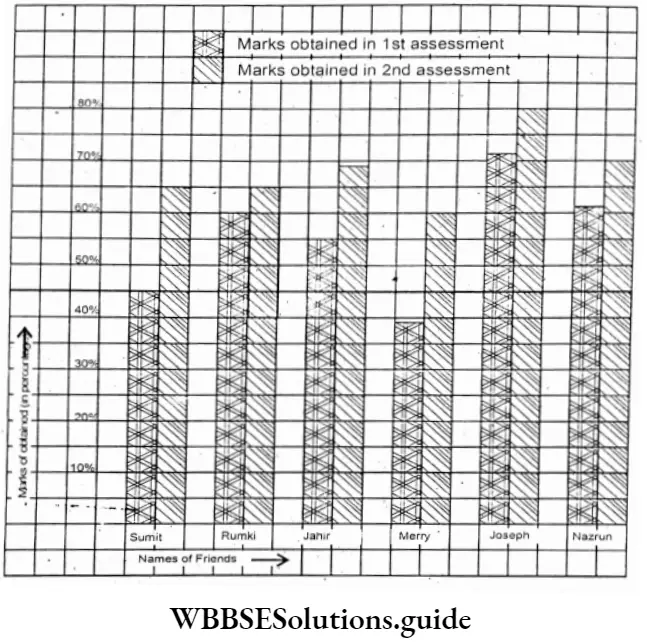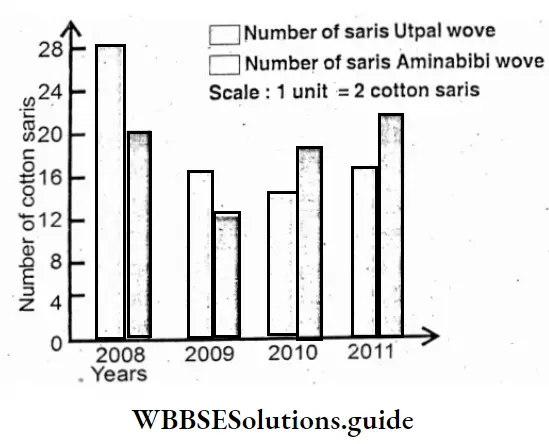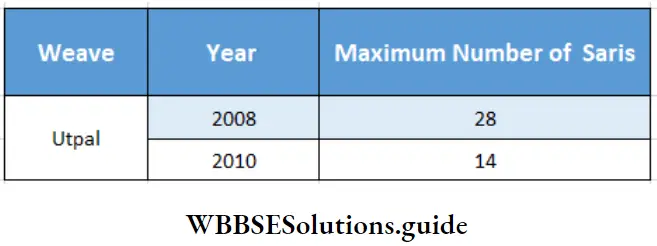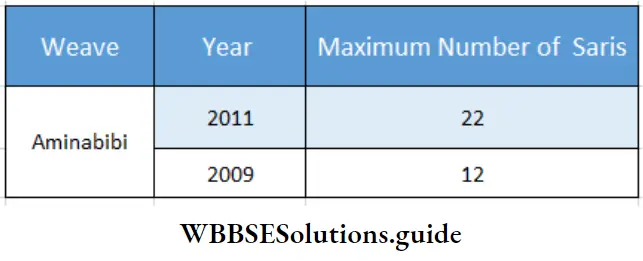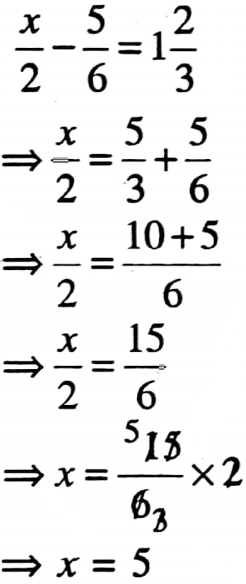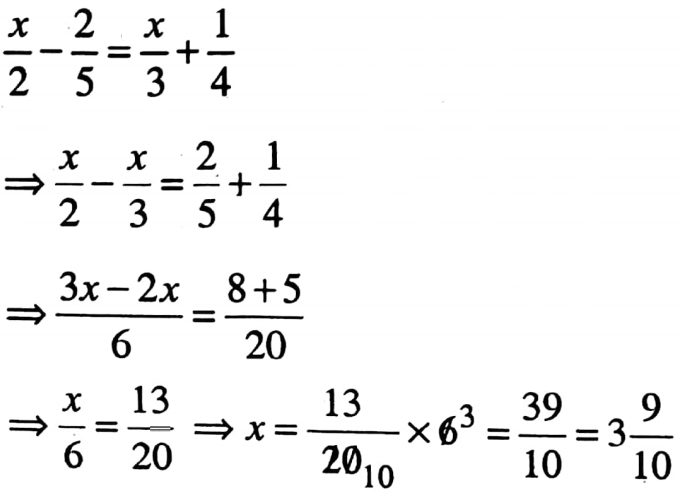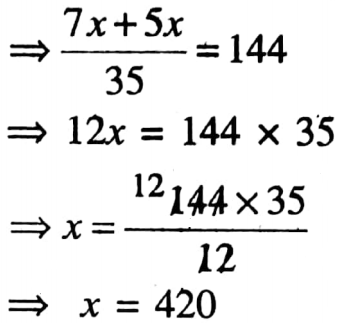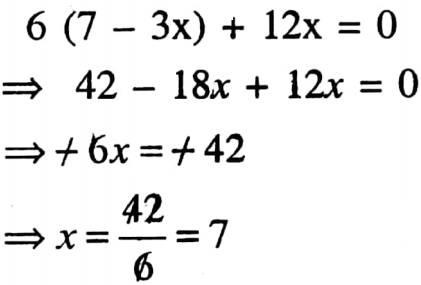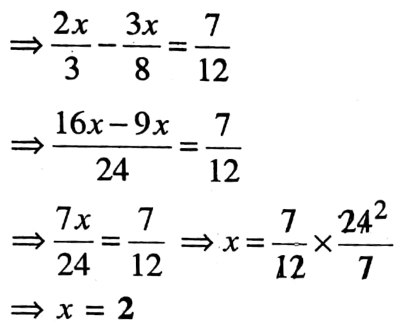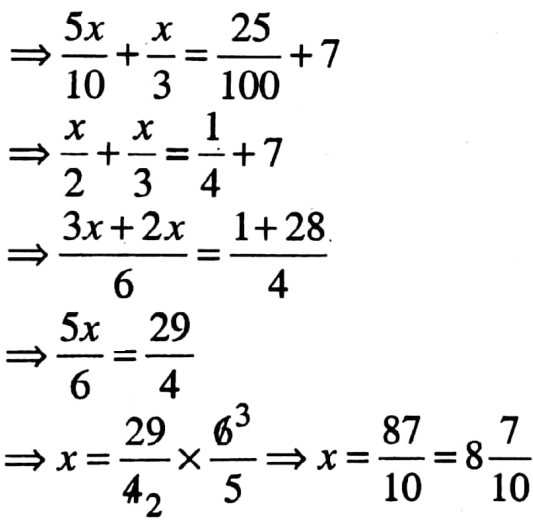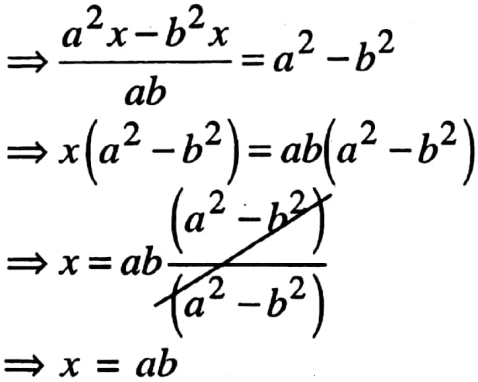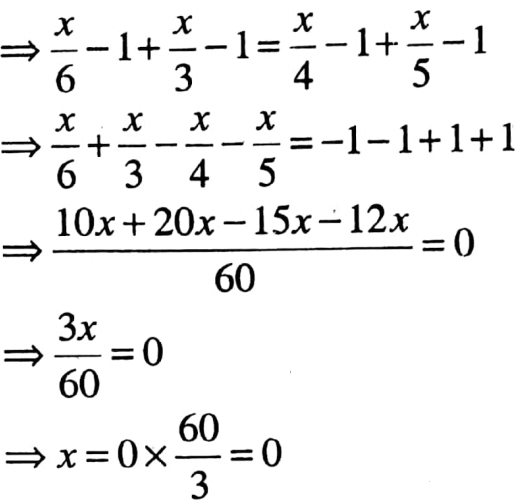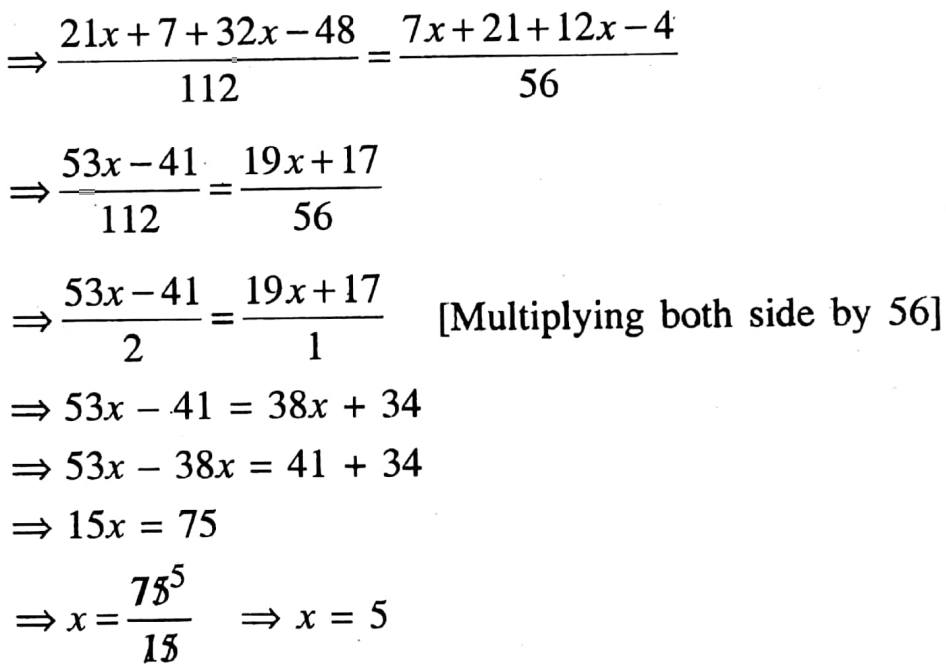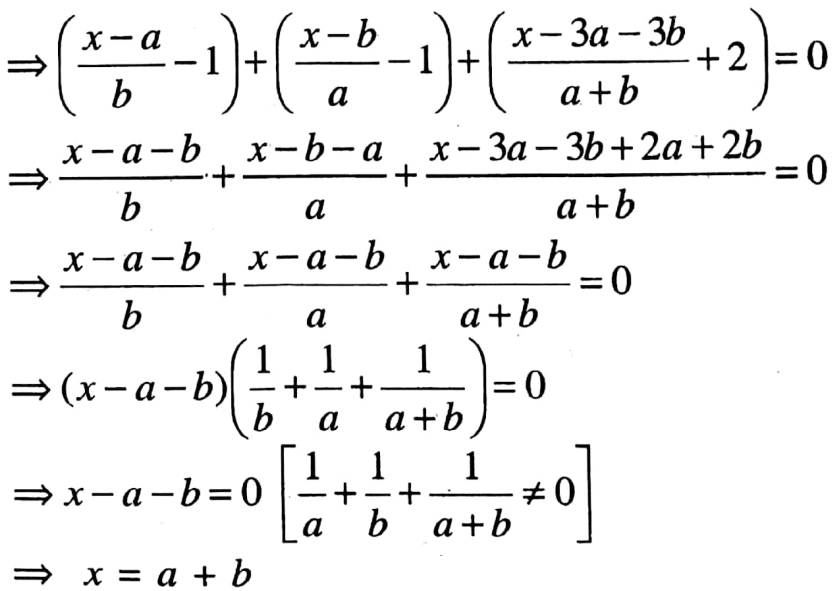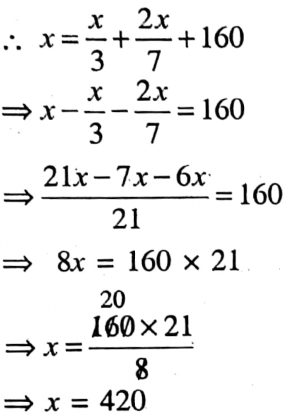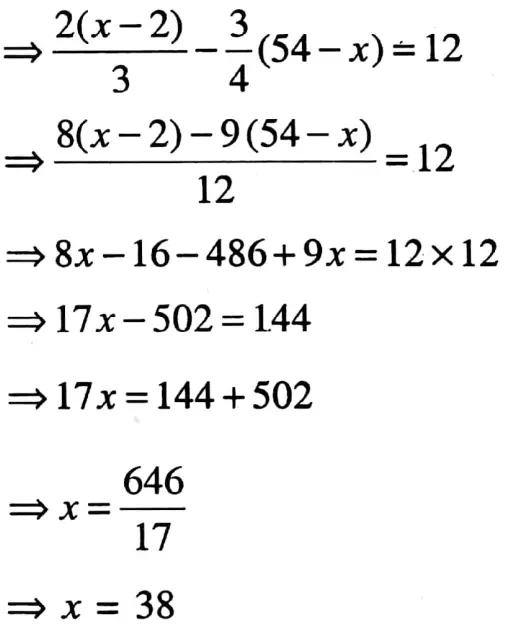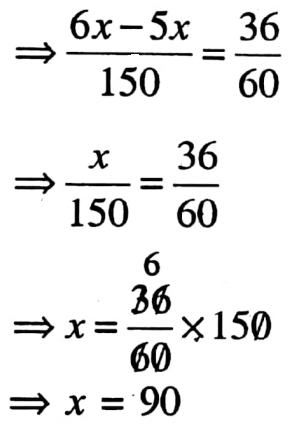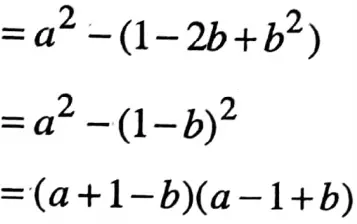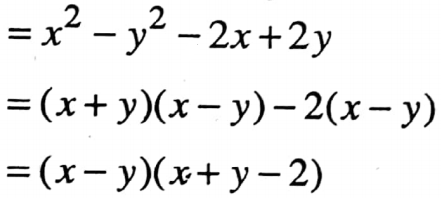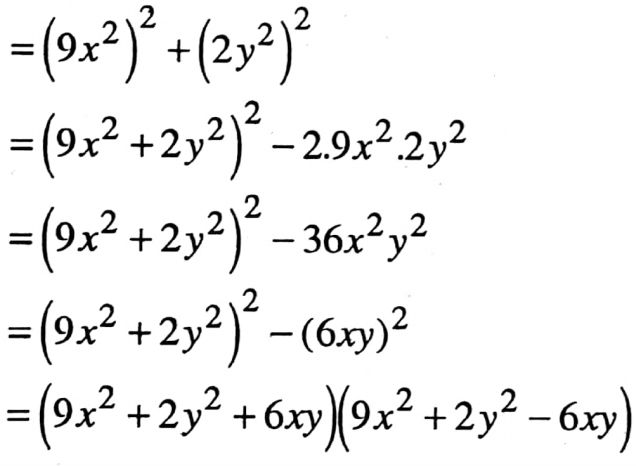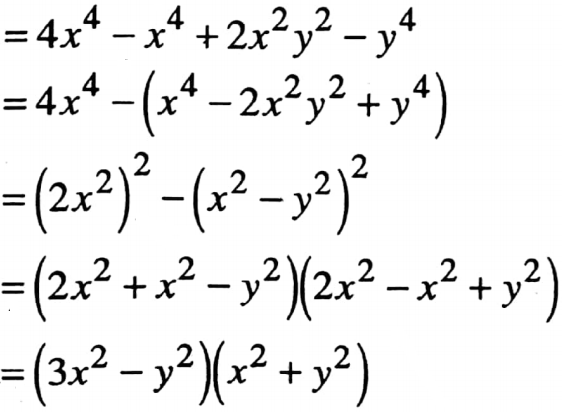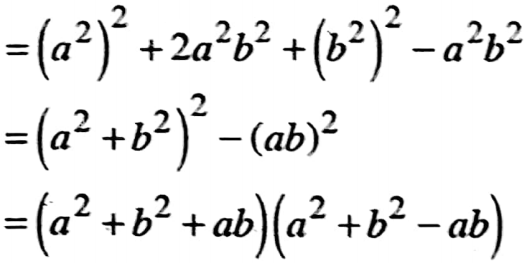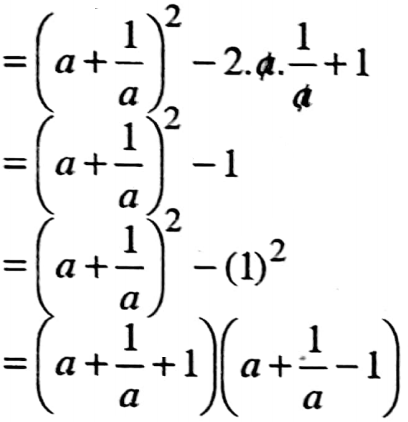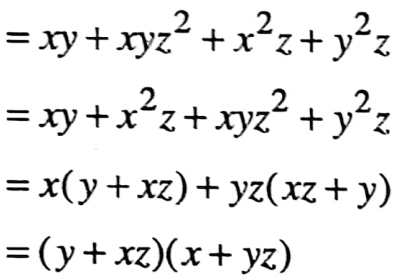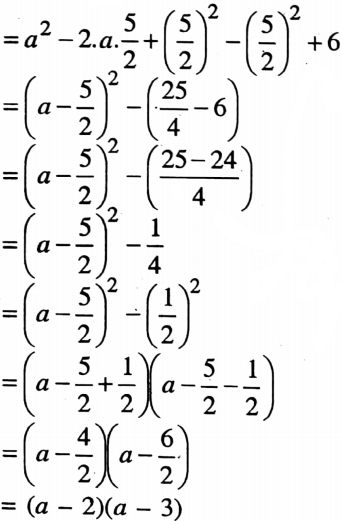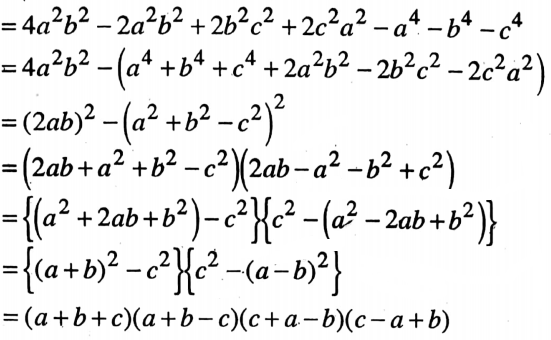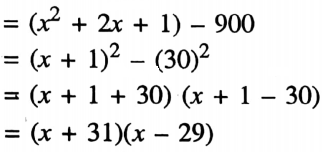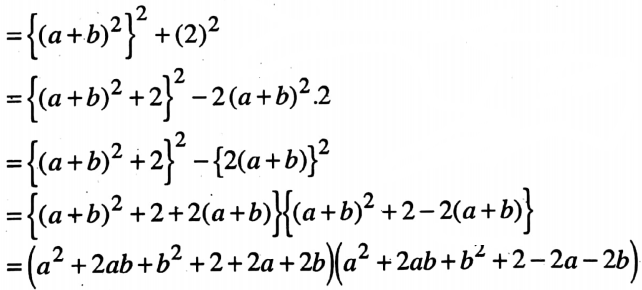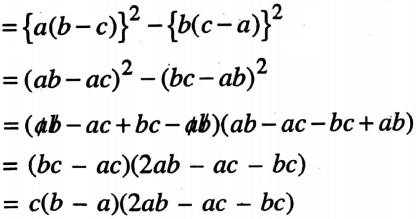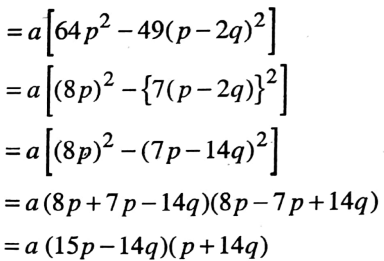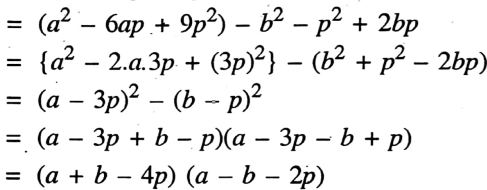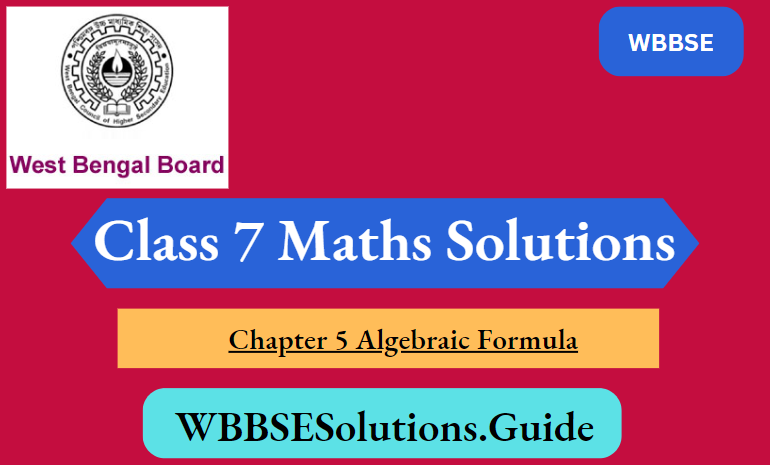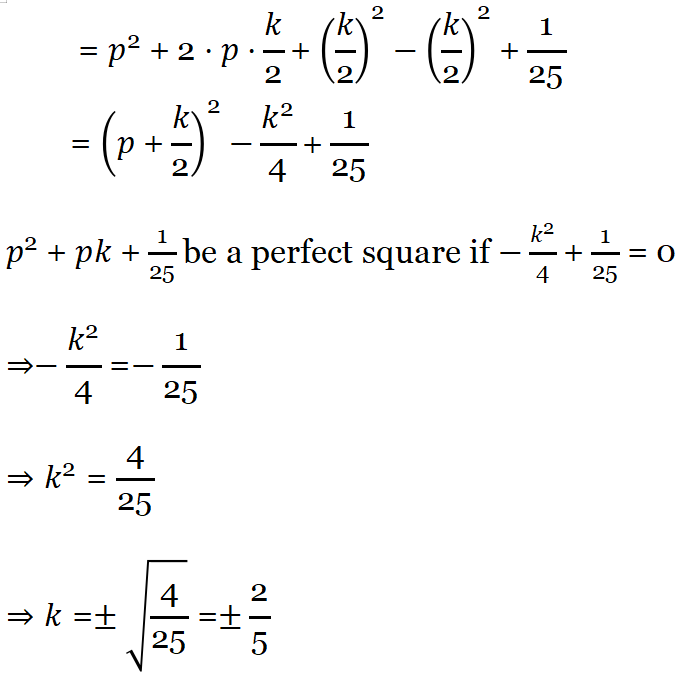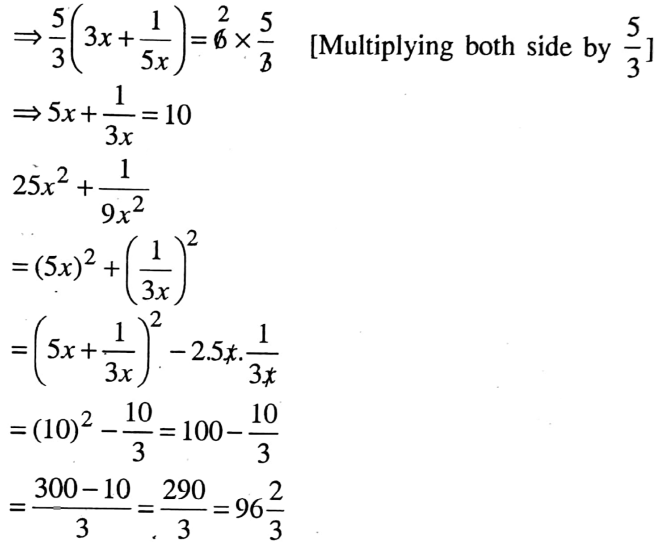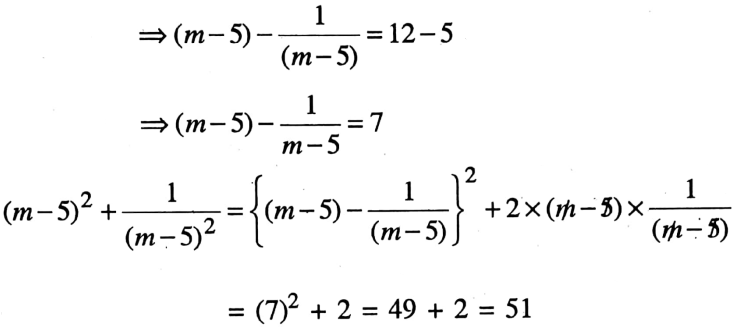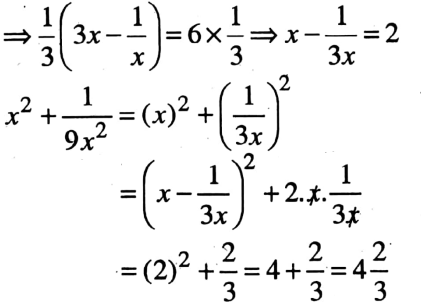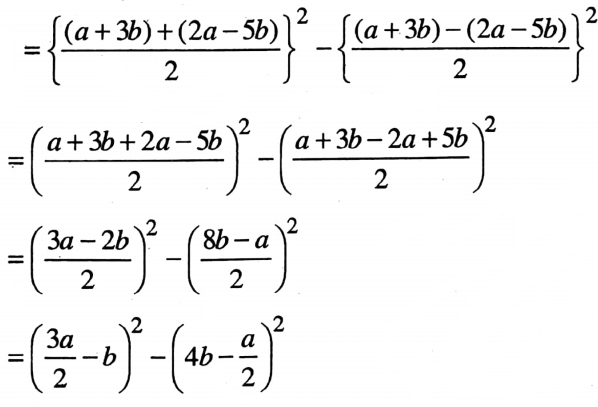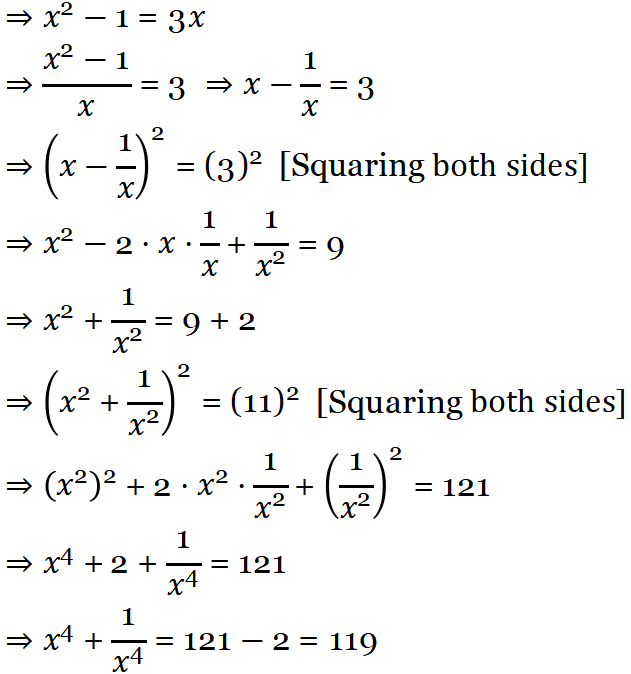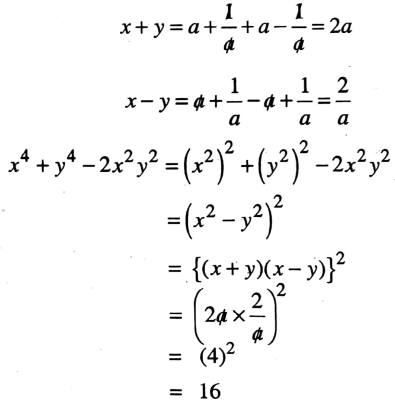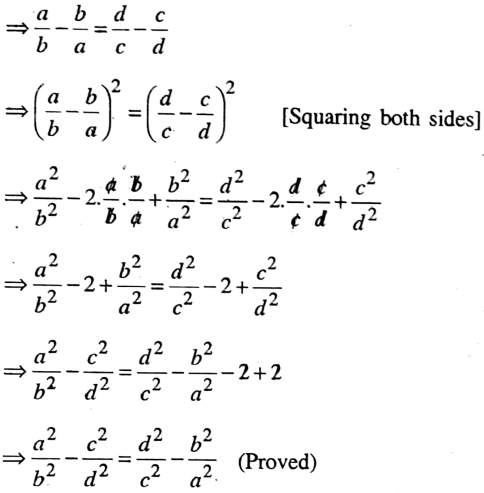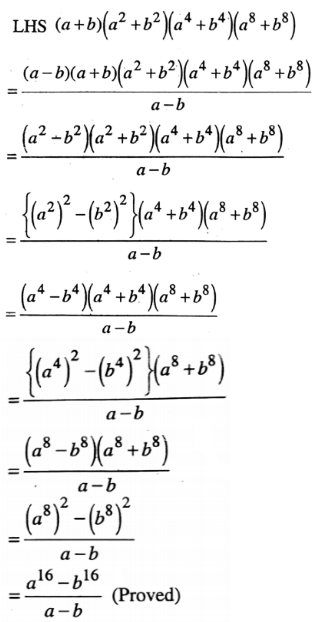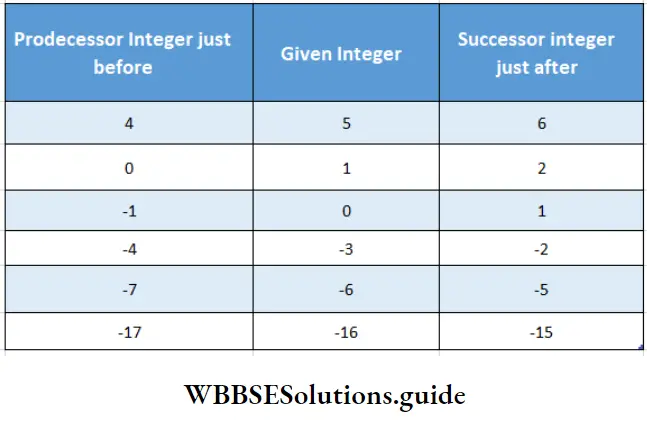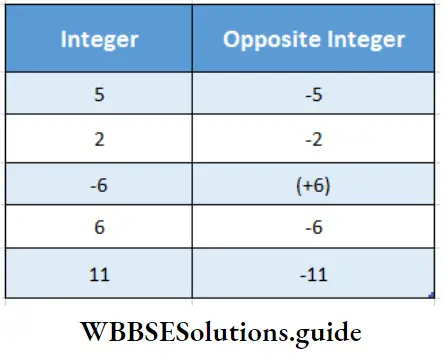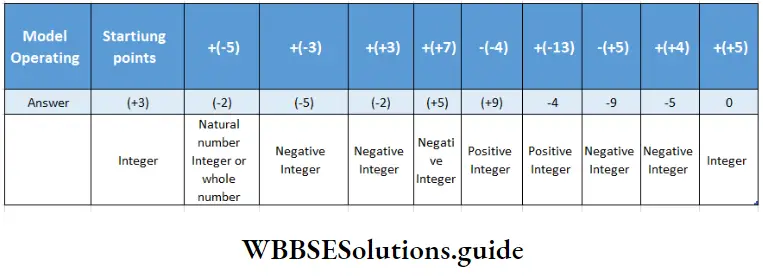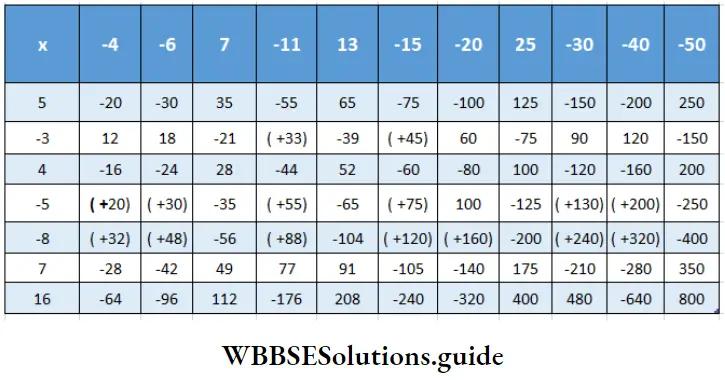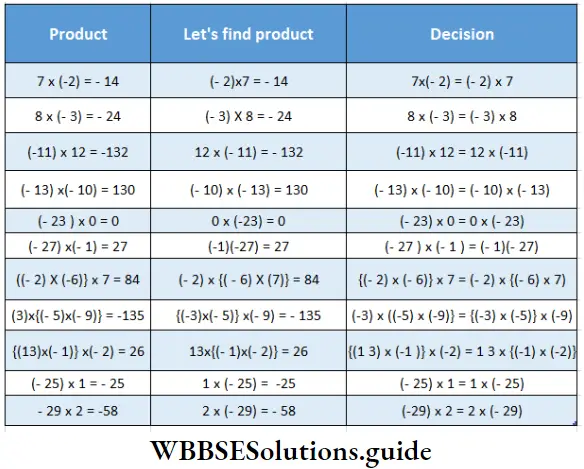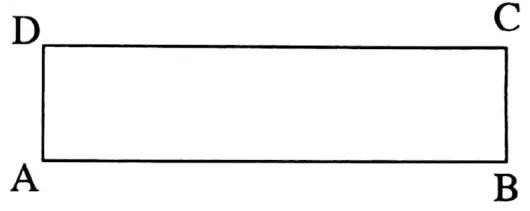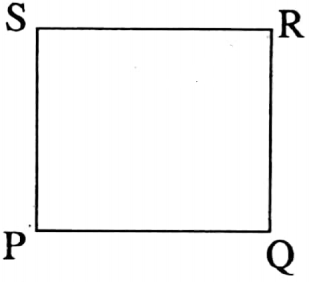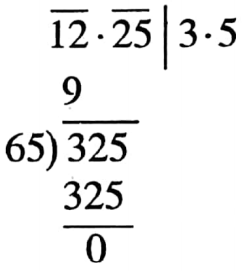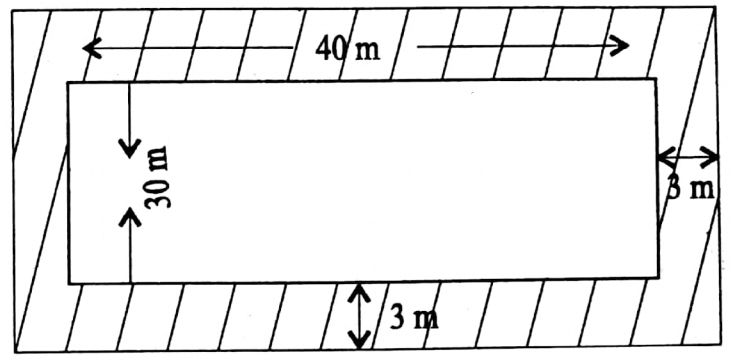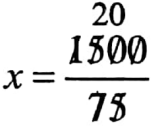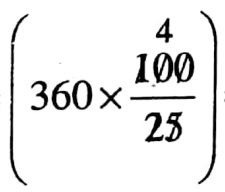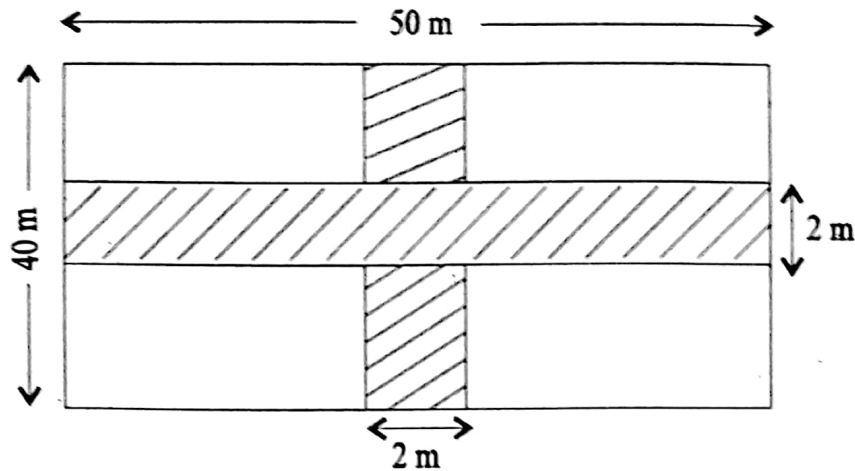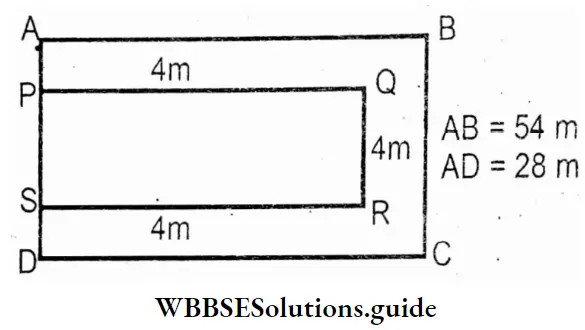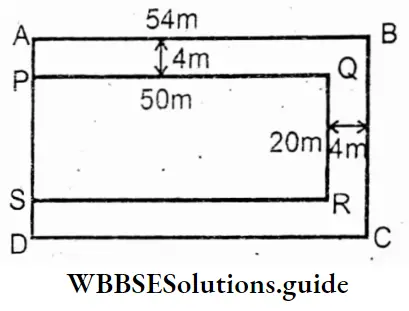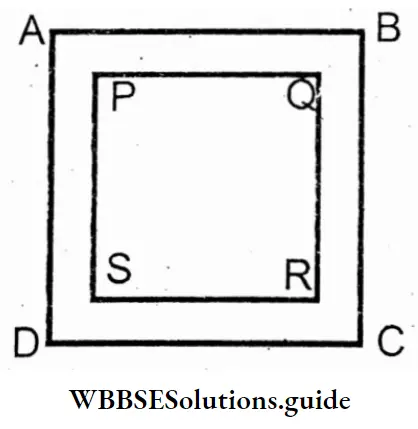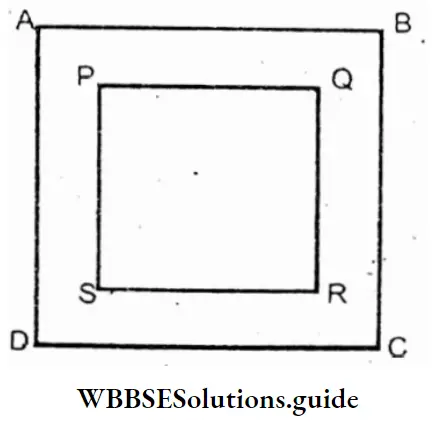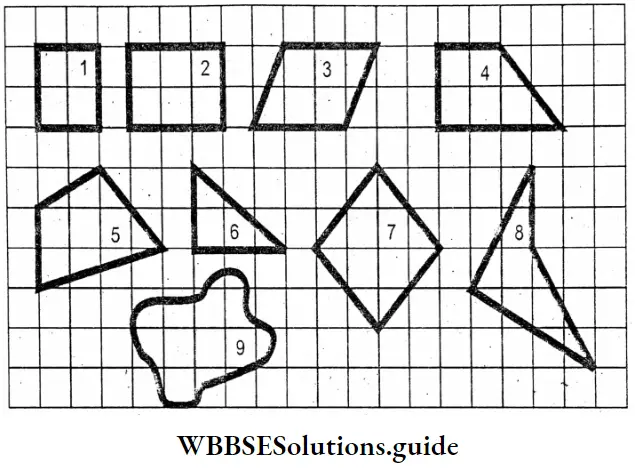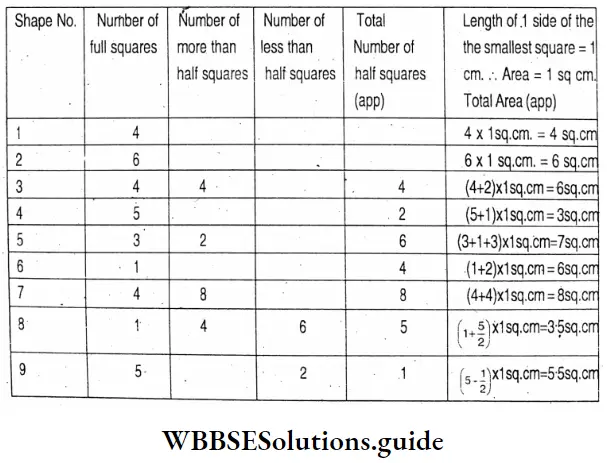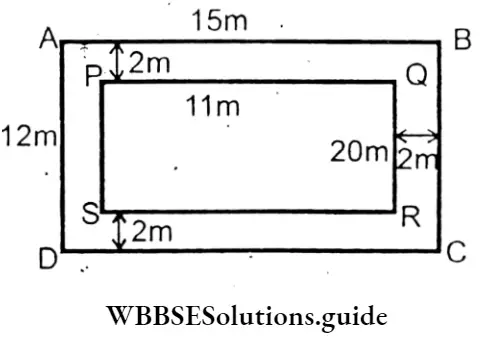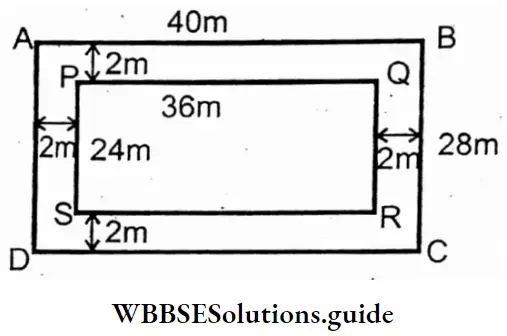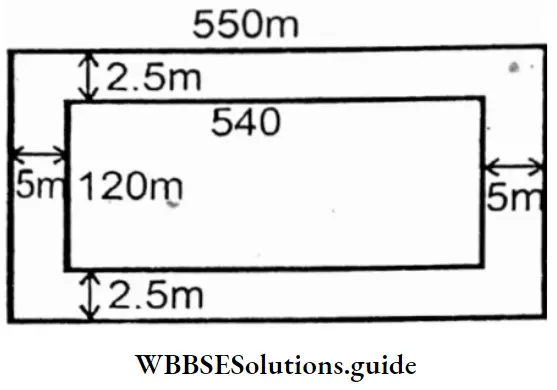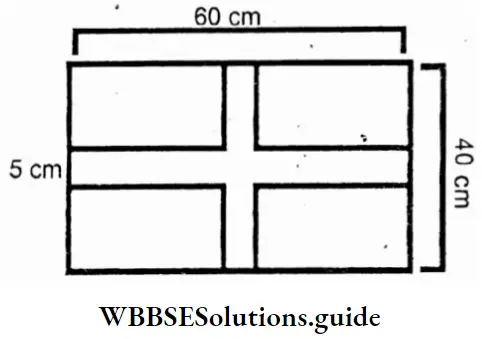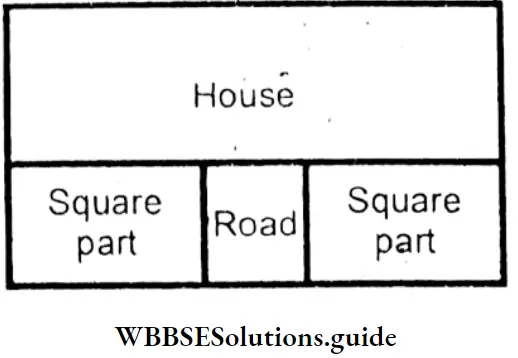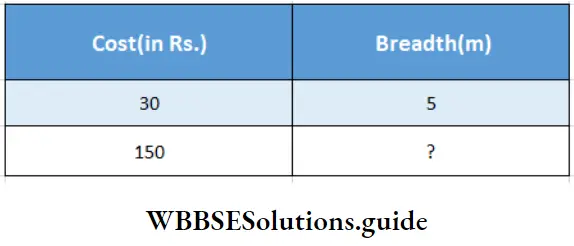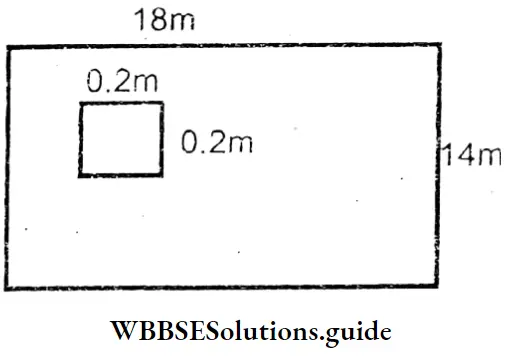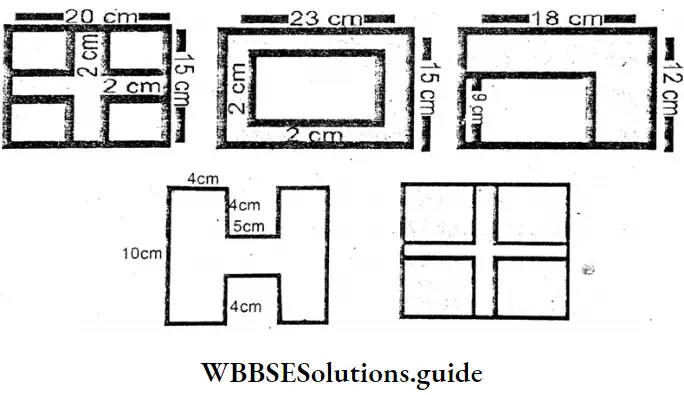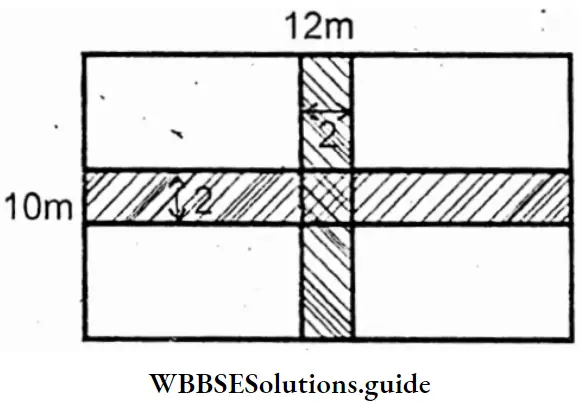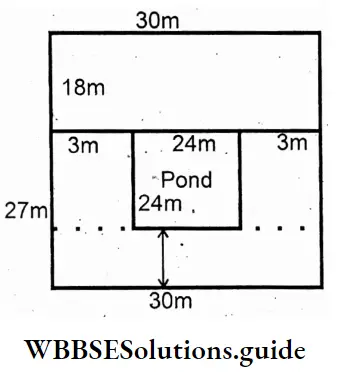WB Class 7 Math Solution Algebra Chapter 4 Algebraic Operations Exercise 4 Solved Problems
1. The term 5, 6, \(\frac{3}{4}\) etc are called constant term and are donated by a, b, c, etc. The term which is always changing are known as variable and are donated by x, y, z etc.
2. The term (7x – 2) and 9x are called algebraic expressing.
3. Relations formed by addition, subtraction, multiplication, and division of few variables and few constants are called an algebraic expression.
4. In expression (5p + 4), p is variable and 5 and 4 are constant.
5. In the algebraic expression 7y, the variable y is multiplied by the constant 7. The factors of 7y are 1, 7, y, and 7y.
6. 7y has only one term and is called a Monomial.
(5p+ 4) has two terms and it is called Binomials.
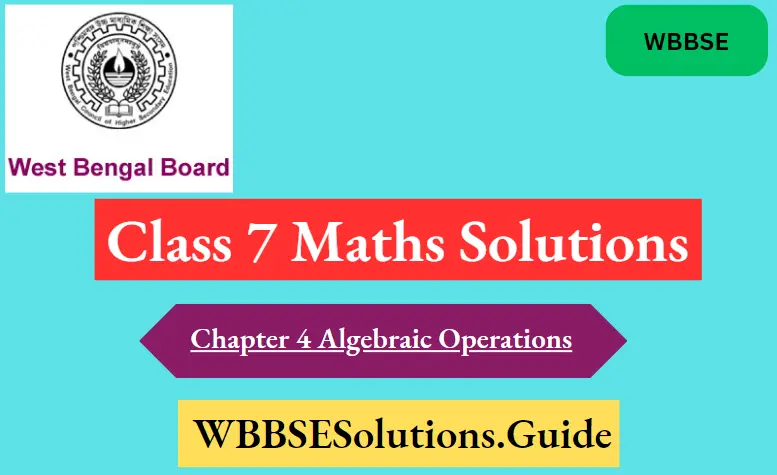
Read and Learn More WBBSE Solutions for Class 7 Maths
Like terms and Unlike terms:
If the terms of algebraic expression are alike. They are called like terms and if they are not alike, they are called, unlike terms.
3a2b and 4a2b are like terms. But 3a2b and 4a2b are unlike terms.
Coefficients: A coefficient is a numerical factor present with any term.
In 5x2, the coefficient of x2 is 5 and the coefficient of 5x is x.
Wbbse Class 7 Maths Solutions
Question 1. Choose the correct answer
1. The sum of (-5x + 3y) and (18x – 15y) is
1. 23x 12y
2. 13x 12y
3. 13x 18y
4. None of these
Solution: -5x + 3y+ 18x-15y
=-5x+18x + 3y 15y
= 13x 12y
So the correct answer is
2. The value of (- 3m2 + 2m+ 2) – (m2 – 2) is
1. -2m2 + 2m
2. -4m2 + 2m + 4
3. -2m2+ 2m – 4
4. -2m2 + 2m + 4
Solution: (- 3m2 + 2m+ 2) – (m2 – 2)
= -3m2 + 2m + 2-m2 + 2
= -3m2 -m2 + 2m + 2 + 2
=-4m2 + 2m + 4
So the correct answer is 2. -4m2 + 2m + 4
3. The value of (-3a2) x (4a2b) x (-2) is
1. 24a2b
2. 24a2b3
3. -24a4b
4. 24a4b
Solution: (-3a2) x (4a2b) x (-2)
=(-3) x (4) x (-2) x a2+2 x b
= 24a4b
So the correct answer is 4. 24a4b
Question 2. Write ‘true’ or ‘false’
1. The number of factors of x2y is 6
Solution:
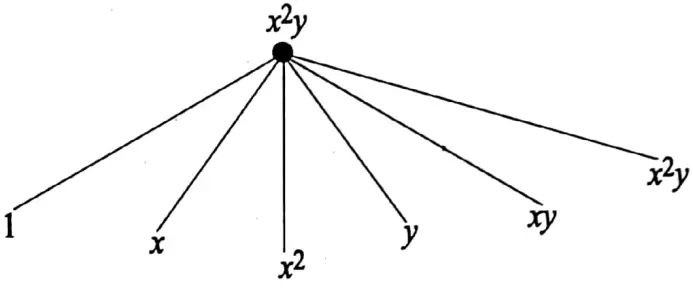
The factors of x2y is 1, x, x2, y, xy, and i.e., the number of factors is 6.
So the statement is true.
2. The coefficient of x2 in (5-6x2y2 + 6xy) is 6y
Solution: In the expression (5-6x2y2 + 6xy) the term with x is (-6x2 y2) whose coefficient of x2 is -6y2
So the statement is false.
Wbbse Class 7 Maths Solutions
3. The value of (-48x9 + 12x6) + 3x3 is (-16x6+ 4x3)
Solution: \(\frac{-48 \dot{x}^9+12 x^6}{3 x^3}\)
= \(-\frac{48 x^9}{3 x^3}+\frac{12 x^6}{3 x^3}\)
=-16x9-3 +4x6-3 =-16x6+4x3
So the statement is true.
Question 3. Fill in the blanks
1. 4x, (5x-2), (7x + 3) together are called _____
Solution: Algebrain expression
2. The product of a2b and (3a-4b) is _____
Solution: a2b (3a – 4b) = 3a3b – 4a2b2
3. If the price of x dozen of pen is ₹ (xy2-7x) then the price of 4 such pen is ₹ _____
Solution: x dozen = 12x
The price of the number of 12x pen is ₹ (xy2 – 7x)
The price of 1 such pen is ₹ \(\frac{x y^2-7 x}{12 x}\)
The price of 4 such pen is ₹ \(\frac{4\left(x y^2-7 x\right)}{12 x}\)
= 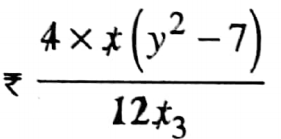
= ₹ \(\left(\frac{y^2-7}{3}\right)\)
Some important rules: a is non zero integers and also m and n are integers
1. am. an = am + n
2. am ÷ an = am – n
3. (am)n = amn
4. \(a^m=\frac{1}{a^{-m}}\)
5. a0 = 1
6. (ab)m = am.bn
7. \(\left(\frac{a}{b}\right)^m=\frac{a^m}{b^m}\)
Proof:
1. \(a^0=a^{m-m}=\frac{a^m}{a^m}=1\)
2. \(a^m=a^{0-(-m)}=\frac{a^0}{a^{-m}}=\frac{1}{a^{-m}}\)
Wbbse Class 7 Maths Solutions
Question 4. Represent the following algebraic expressions into ‘factor free’ type of figure mentioning the prime factors of each term. Also mention the types these expressions with respect to their number of terms.
1. xy + yz + zx
2. x2 + x + 1
Solution:
1.
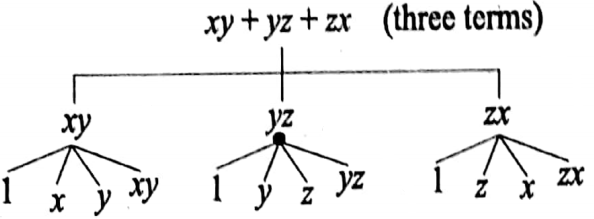
2.
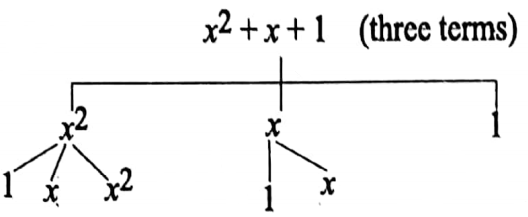
Question 5. Find the numerical coefficients of the terms, other than the constant term.
1. x2 + 6x + 5
2. x – 7xy + 9y
Solution: 1. x2 + 6x + 5
The numerical co-efficient of x2 is 1.
The numerical co-efficient of x is 6.
2. x – 7xy + 9y
The numerical co-efficient of x, xy, and y are 1, -7, and 9 respectively.
Question 6. Add
1. 7a2b+3ab2-9, 4a2b – 5ab2 + 10, a2b + ab2 – 15
2. xy-3yz.+4zx, 3xy+5yz-6zx, -2xy + 3yz-zx
Solution:
1. 7a2b+3ab2-9, 4a2b – 5ab2 + 10, a2b + ab2 – 15
= 7a2b+ 4a2b + a2b+3ab2 – 5ab2 +ab2 – 9+ 10 – 15
= 12a2b – ab2 – 14
Another method:
7a2b+3ab2-9
4a2b-5ab2 + 10
+ a2b + ab2 – 15
= 12a2b- ab2 – 14
2. (xy 3yz+4zx) + (3xy + 5yz-6zx) + (-2xy + 3yz – zx)
= 
= xy + 3xy – 2xy – 3y + 5yz + 3yz + 4zx-6zxzx
= 2xy + 5yz-3zx.
Question 7. Subtract
1. (3x2 – 4xy- 5y2) from (-7x2-3xy+4y2)
2. (m3 – 3m2 + 4m – 5) from (m3+ 3m2 – 6m + 2)
Solution:
1. (-7x2 -3xy + 4y2) – (3x2-4xy – 5y2)
= -7x2-3xy+4y2-3x2 + 4xy + 5y2
= -7x2-3x2 – 3xy + 4xy+4y2+5y2
= -10x2 + xy + 9y2
Alternative method
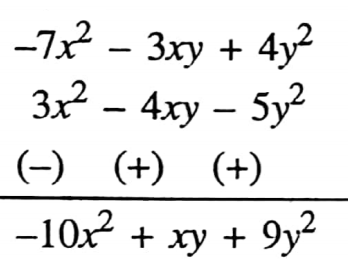
2. (m3+ 3m2– 6m+ 2) – (m3-3m2 + 4m -5)
= m3+3m2-6m+2 -m3 + 3m2 – 4m + 5

= 6m2 10m +7
Question 8. How much must be added to (6y2 – 6y+ 1) to get (-15y2+ 7y – 7)
Solution:
The required expression is (-15y2 + 7y – 7) (6y2 – 6y+1)
=-15y2+ 7y-7-6y2+6y+ 1
=-15y2+ 13y-6
Question 9. What must be subtracted from (9x2-3x+7) to get (-3x2+6x-13)
Solution:
The required expression is (9x2-3x+7)-(-3x2+6x-13)
= 9x2 – 3x + 7 + 3x2-6x + 13
= 12x2 – 9x+20
Wbbse Class 7 Maths Solutions
Question 10. Subtract the sum of (-5y2 + 3y -7) and (9y2-7y+ 12) from the sum of (y2+2y-6) and (12y – y2 + 5)
Solution:
The required expression is
{(y2+2y-6)+(12y-y2+ 5)} – {(-5y2+ 3y 7) + (9y2-7y+ 12)}
= 
= (14y -1)- (2y2-4y+5)
=14y -1 – 2y2 + 4y – 5
=-2y2+18y-6
Question 11. Multiply
1. \(\left(-\frac{3}{5} a^2 b\right) \times\left(\frac{15}{8} a b^2 c\right) \times\left(\frac{4}{9} b c^2\right)\)
2. \(\left(\frac{5}{3} a^2 b c\right) \times\left(-\frac{4}{5} a b^2 c\right) \times\left(-\frac{6}{15} a b c^2\right)\)
3. (3a-4b)(5a + 6b)
4. (a2 – b2 + c2)(a2 + b2 – c2)
Solution:
1. \(\left(-\frac{3}{5} a^2 b\right) \times\left(\frac{15}{8} a b^2 c\right) \times\left(\frac{4}{9} b c^2\right)\)

2. \(\left(\frac{5}{3} a^2 b c\right) \times\left(-\frac{4}{5} a b^2 c\right) \times\left(-\frac{6}{15} a b c^2\right)\)

3. (3a-4b)(5a + 6b)
= 3a (5a + 6b) – 4b (5a + 6b)
= 15a2 + 18ab – 20ab – 24b2
=15a2-2ab-24b2
4. (a2-b2+c2)(a2+b2-c2)

Wbbse Class 7 Maths Solutions
Question 13. Divide the first expression by the second.
1. 20a2b-25ab3c2-30a2bc3, 5ab
2. 6abc-18a2bc2 + 24a3b2c3, -6abc
3. a2b4 + a4b3 – a3b54, -a4b
Solution:
1.
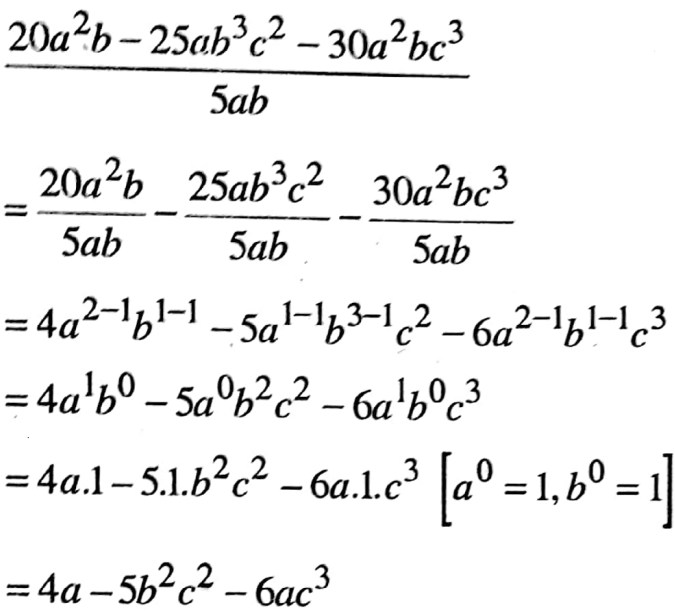
2.
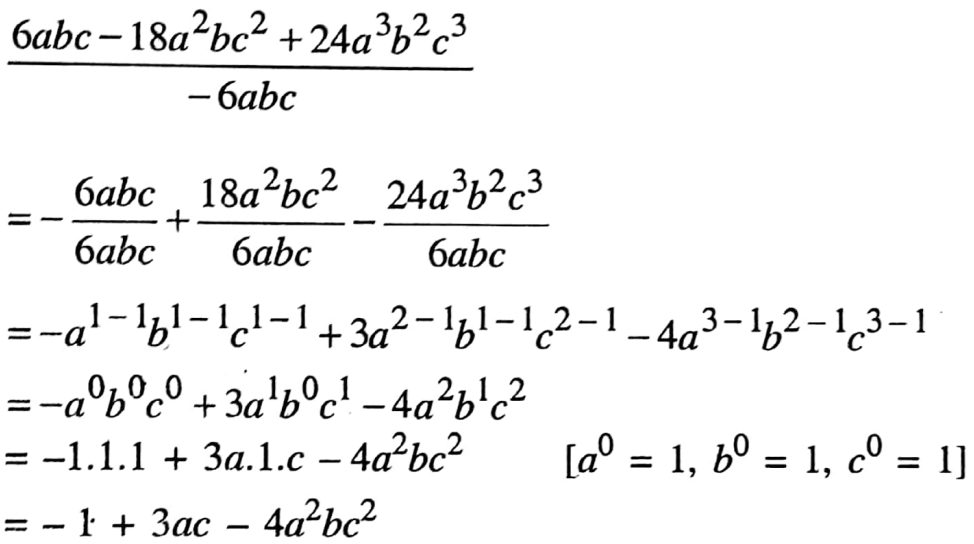
3.
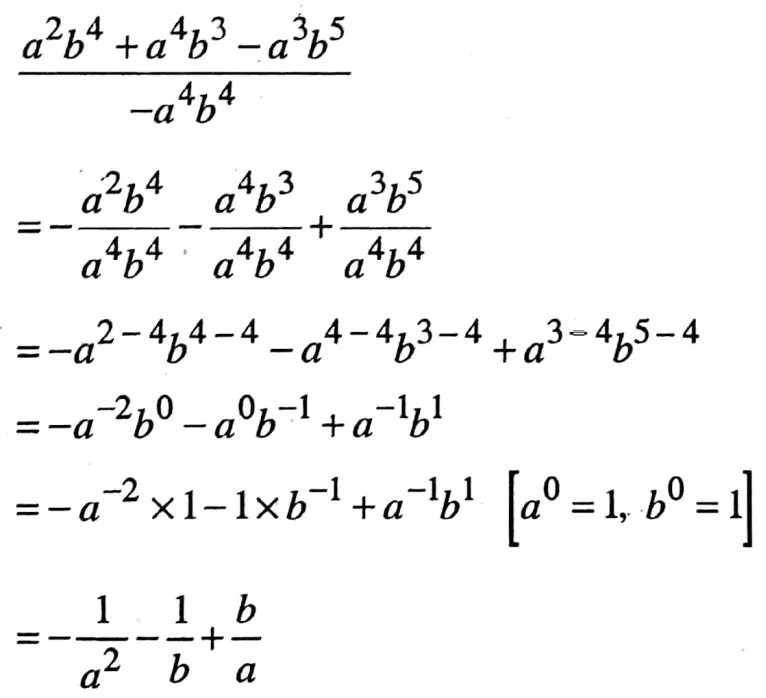
Question 14. If A = 2x + 3y – 4z, B= 2y+ 3z4x and C2z+3x4y. Find the sum of (A+B+C) and (A B+ C)
Solution:
Given
If A = 2x + 3y – 4z, B= 2y+ 3z4x and C2z+3x4y.
(A+B+ C) + (A- B+ C)
= 2A + 2C
= 2(2x + 3y 4z) + 2(2z+3x-4y)
=4x+6y8z+4z+6x-8y
= 10x 2y4z.
Question 15. If P = 3x2 + 2xy + y2, Q=-3x2 – 2xy + y2 and R = x2 + y2 and x = y – 2. Find the value of (P+Q + R).
Solution:
Given
If P = 3x2 + 2xy + y2, Q=-3x2 – 2xy + y2 and R = x2 + y2 and x = y – 2.

= x2 + 3y2
=(-2)2 + 3 (-2)2 [Putting the value of x and y]
= 4+3×4
= 16.
Question 16. Simplify the following
1. 3x2+ 2x(x + 3) -4x (3x-5)
2. (a2 + b2)(a2 – b2) + (b2 + c2)(b2 – c2) + (c2 + a2)(c2 – a2)
3. (x2+5x)(x -1) – (x2 + 2x)(x 1) – 5x (x + 1)
4. (x+3)(x-3)+(x+4)(x-4) – 2x2 + 25
5. (x2 + 2x – 1)(x − 1) + (x2 – 2x + 1)(x + 1) − 2x(x − 1)
Solution:
1. 3x2+ 2x(x + 3) -4x (3x-5)
= 3x2+2x2+6x-12x2 + 20x
= −7x2 + 26x
2. (a2 + b2)(a2 – b2) + (b2 + c2)(b2 – c2) + (c2 + a2)(c2 – a2)
= a2(a2-b2) + b2(a2 – b2) + b2(b2 – c2) + c2(b2 – c2) + c2 (c2 – a2) + a2 (c2 – a2)

= 0
3. (x2 + 5x)(x – 1) – (x2 + 2x)(x – 1) – 5x (x + 1)
= x2(x -1) + 5x(x – 1) – x2 (x – 1) – 2x(x – 1)- 5x(x + 1)

= -2x2 – 8x
4. (x+3)(x-3)+(x+4)(x-4)- 2x2 + 25.
= x(x-3)+3(x-3) + x(x-4)+4(x-4) – 2x2 + 25

= 0
5. (x2 + 2x-1)(x 1) + (x2 – 2x + 1)(x + 1) 2x(x-1)
= x2(x-1) + 2x(x − 1) − 1(x − 1) + x2 (x + 1) − 2x(x + 1) + 1(x + 1) − 2x(x-1)

= 2x3 – 2x2 – 2x + 2
WB Class 7 Math Solution Algebraic Operations
Algebraic Operations Exercise 6.1
Let’s write the algebraic expression and find the number of terms.
4x, 3x + 1, 2x + 1, 6p – 1, 3y + 6
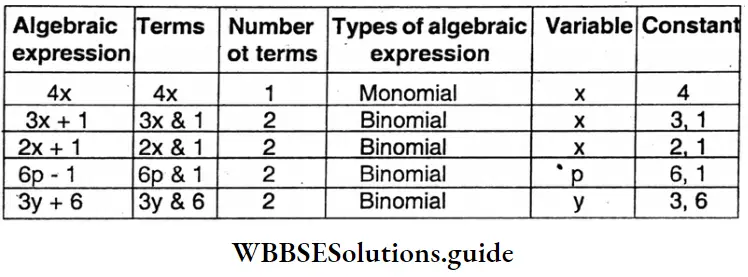
Class 7 Math Solution WBBSE Algebraic Operations Exercise 6.2
Question 1. Let’s draw ‘factor tree’ type figures and from there let’s find the number of terms and factors of the following algebraic expression :
1. 2x + 1
Solution:
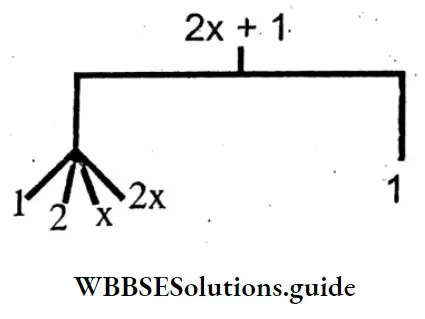
2. 3y+6
Solution:
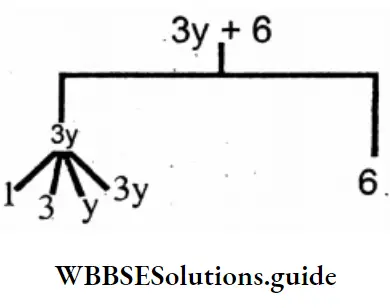
Question 2. Let’s study the algebraic expressions given below and fill in the gaps accordingly.
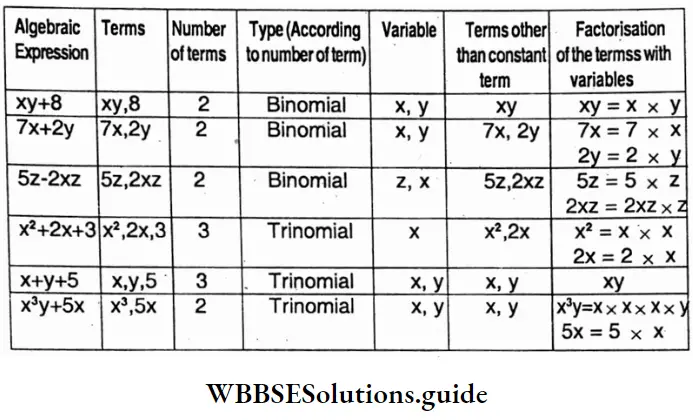
Class 7 Math Solution WBBSE Algebraic Operations Exercise 6.3
Question 1. Let’s form algebraic expressions from the statements given below-
1. y is added to x
Solution: x + y
2. x is subtracted from z
Solution: z – x
3. q is added to twice of p
Solution: 2p + q
4. Multiply x with a square of x.
Solution: x2.x = x3
5. \(\frac{1}{4}\) th of the sum of x and y
Solution: \(\frac{x+y}{4}\)
6. 7 is added to 4 times the product of a & b
Solution: 4ab + 7
7. Half of y is added to twice of x
Solution: 2x +\(\frac{1}{2}\) y
8. The product of x and y is subtracted from sum of x and y.
Solution: (x + y) – xy.
Question 2. Let’s Let’s observe the patterns match and fill in the chart
1.
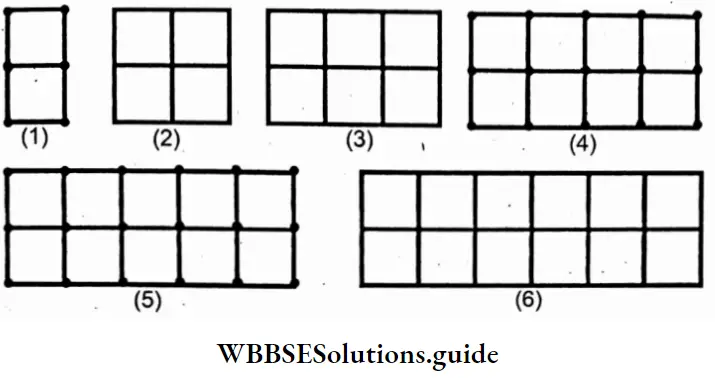
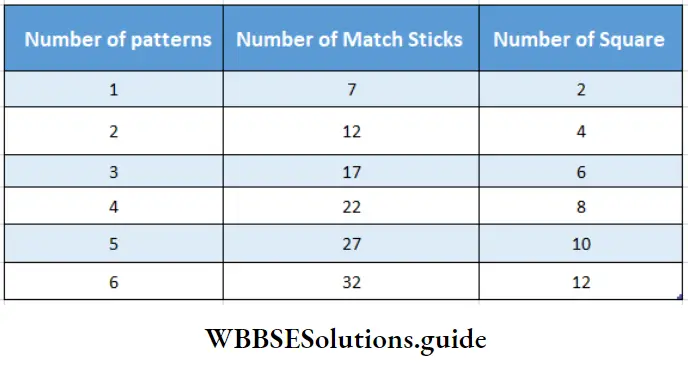
General Expression 5x + 2 = Number of Match Sticks.
2. Let’s form the general expression with a variable
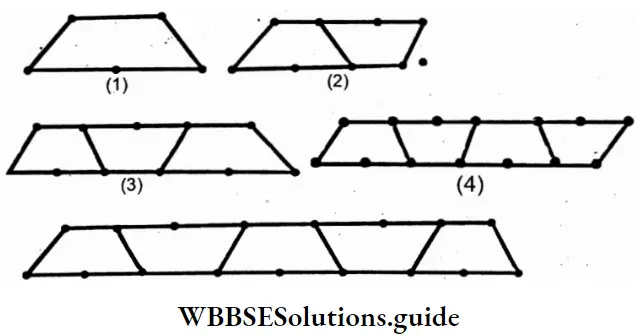
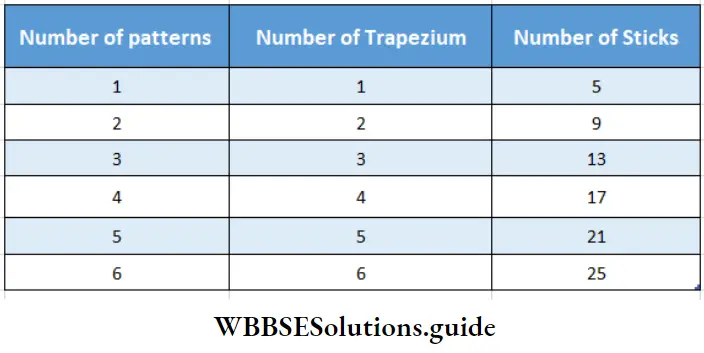
General Expression, Number of sticks = 4x + 1 where x = No. of trapezium
Question 3. Let us represent the following algebraic expressions into ‘factor tree’ type of figure mentioning the prime factor of each term. Also mention thetypes of these expressions with respect to their number to terms.
1. 5x (Monomial)
Solution:
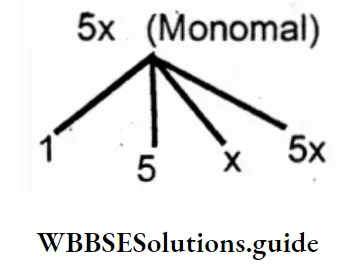
2. 7 + 2x + x2 (Trinomial)
Solution:
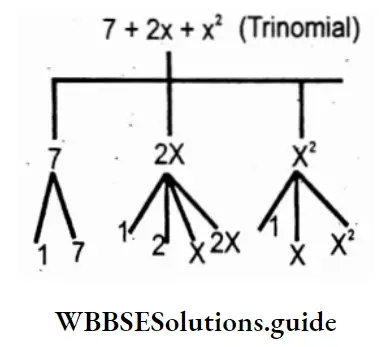
3. x2 + x + 1 (Trinomial)
Solution:
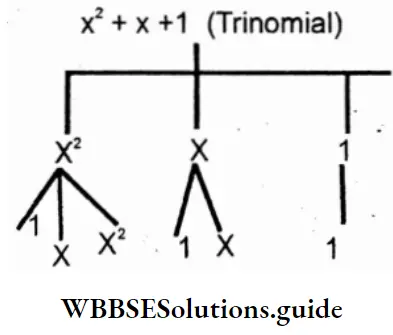
4. 2x2y + 7 (Binomial)
Solution:
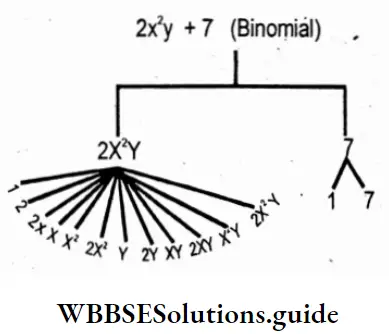
5. 2y3 + y (Binomial)
Solution:
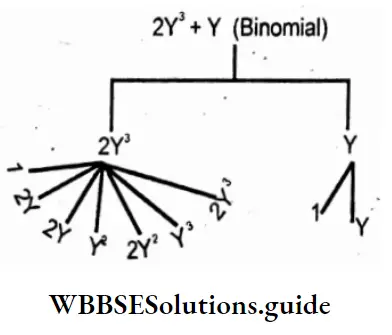
6. x2y+xy2+xyz
Solution:
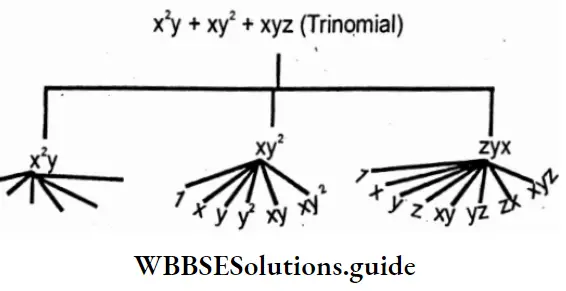
7. x2y + 2x2y2 (Binomial)
Solution:
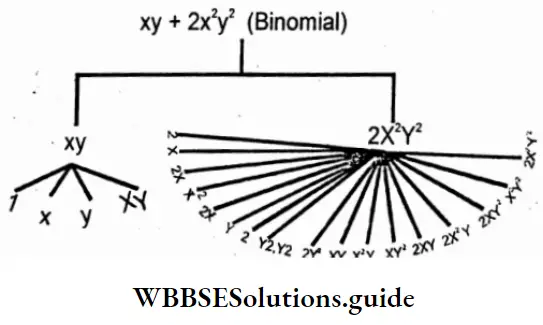
8. 5x + 2y (Binomial)
Solution:
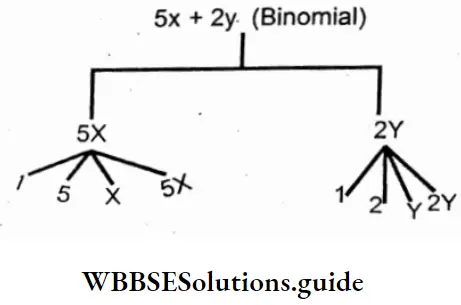
Question 4. Let’s find the numerical coefficients of the terms, other than constant
term:
1. 2x + 3y
Solution: 2, 3.
2. x2 + 2x + 5
Solution: 1, 2.
3. x + 5xy – 7y
Solution: 1, 5, – 7.
4. – 5 – z
Solution: – 1
5. x3 + x – y
Solution: – 1,1, 1,
6. \(\frac{x}{2}+4\)
Solution: \(\frac{1}{2}\)
Question 5. In the following algebraic expression let’s find the coefficient of x in the terms or terms which have ‘x’ as their factor.
1. y3x + y2
Solution: y3x, y3
2. 5z2 – 8zx
Solution: – 8zx, – 8z
3. – x – y + 2
Solution:– x, – 1
4. 4 + y +.yx
Solution: yx, y
5. 2 + x + xy2
Solution: x, 1 , xy2, y2
6. 5xy4-1 4
Solution: 15xy4, I5y4
Question 6. Let’s group the like terms from the algebraic expressions given below. 2x, y, 12xy, 13y2, – 5x, 18y, – 4xy, – 2y2, 21x2y, 3x, 3xy, – xy, – y, – 6x2, -1 5x2.
Solution:
2x, y, 12xy, 13y2, – 5x, 18y, – 4xy, – 2y2, 21x2y, 3x, 3xy, – xy, – y, – 6x2, -1 5x2=
(2x, – 5x, 3x); (y, 18y, – y), (12xy, – 4xy, 3xy, – xy), (13y2, – 2y2), (21x2y), (- 6x2, – 15x2)
Question 7. Let’s identify the like and unlike pairs of terms with reasons from the pairs of terms given below.
- 2x, 3y
- 7x, 8x
- 29x, 6Tx
- 4xy, 6yz
- 15 yx, 8xy
- 5xy, 6x2y2
Solution:
Like term: 2,3,5
Unlike term: 1,4,5
Question 8. From the algebraic expressions given below, let’s write the terms which contain x2. And also find the coefficient of x2.
1. 5- xy2
Solution: No
2. – 6x2 – 8y
Solution: -6
3. 3x2 – 1 5xy2 – 8y2
Solution: 3
4. 2 + 3k2y+4x
Solution: + 3y
5. 5 – 6x2y2 + 6xy
Solution: – 6y2
Class Vii Math Solution WBBSE Algebraic Operations Exercise 6.4
Question 1. Let’s add the following
1. (- 5x + 3y) and (1 8x – 1 5y)
Solution :
Given
(- 5x + 3y) and (1 8x – 1 5y)
⇒ (- 5x + 3y) + (1 8x – 1 5y)
= – 5x + 1 8x + 3y – 1 5y
= 1 3x – 1 2y
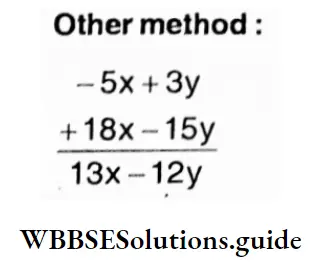
2. (7a – 8b + 2c) and (2a + 3b – d)
Solution :
Given
(7a – 8b + 2c) and (2a + 3b – d)
⇒ (7a – 8b + 2c) + (2a + 3b – d)
= 7a + 2a + (- 8b + 3b) + 2c – d
= 9a – 5b + 2c – d
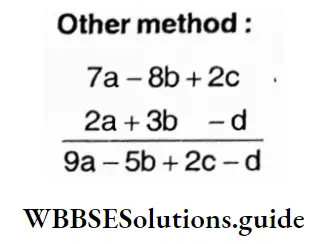
Question 2. Let’s subtract:
1. (-mn – m + n) from (4mn + m + n)
Solution :
Given
(-mn – m + n) and (4mn + m + n)
⇒ (-mn – m + n) – (4mn + m + n)= (4mn + m + n) – (-mn – m + n)
= 4mn + m + n + mn + m- n
= 4mn + mn + m + m + n- n
= 5mn + 2m
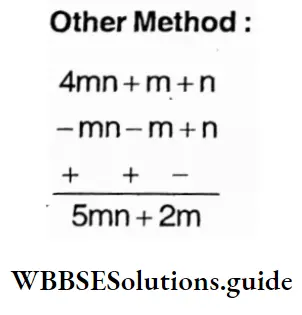
2. (2q2 + 3P2 – qp + pq2) from (p2 + q2 – pq + p2q)
Solution:
Given
(2q2 + 3P2 – qp + pq2) and (p2 + q2 – pq + p2q)
= (p2 + q2 – pq + p2q) – (2q2 + 3p2 – pq + pq2)
= p2 + q2 – pq + p2q – 2q2 – 3p2 + pq – pq2
= p2 – 3r2 + q2 – 2q2 – pq + pq + p2q – pq2
= – 2p2 – q2 + p2q – pq2
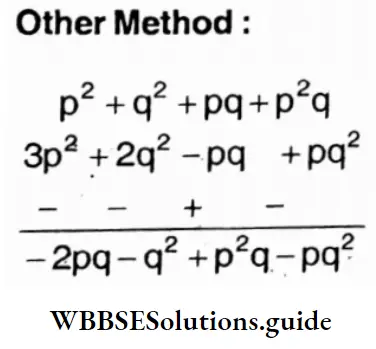
Class Vii Math Solution WBBSE Algebraic Operations Exercise 6.5
Question 1. Lefs add the algebraic expressions (2x2 + x + 2) and (x2 + 2x + 2) with the use of colored cards.
Solution:
Let’s add :
Given
(2x2 + x + 2) and (x2 + 2x + 2)
⇒ (2x2 + x + 2) + (x2 + 2x + 2)
= 2x2 + x2 x + 2x + 2 + 2
= 3x2 + 3x + 4
Question 2. Let’s subtract the algebraic expressions (3x2 + 3x – 2) from (5x2 – 2x – 3)
Solution:
Given
(3x2 + 3x – 2)and (5x2 – 2x – 3)
Let’s subtract the algebraic expressions
(3x2 + 3x – 2) from (5x2 – 2x – 3)
= (5x2 – 2x – 3) – (3x2 + 3x – 2)
= 5x2 – 2x – 3 – 3x2 – 3x + 2
= 5x2 – 3x2 – 2x – 3x – 3 + 2
= 2x2 – 5x 1
Algebraic Operations Exercise 6.6
Question 1. Let’s add the following :
1. (- 5x + 3y) and (18x – 1 5y)
Solution:
Given
(- 5x + 3y) and (18x – 1 5y)
– 5x + 3y + 18x – 15y = – 5x + 18x + 3y – 15y
= 13x – 1 2y
2. (7a – 8b + 2c) and (2a + 3b – d)
Solution:
Given
(7a – 8b + 2c) and (2a + 3b – d)
7a – 8b + 2c + 2a + 3b – d = 7a + 2a – 8b + 3b + 2c – d
= 9a – 5b + 2c> d
Question 2. Let’s Let’s subtract.:
1. (- mn – m + n) from (4mn + m + n)
Solution:
Given
(- mn – m + n) and (4mn + m + n)
(4mn + m + n). – (- mn – m + n)
= 4mn + m + n + mn + m- n
= 4mn + mn + m + m + n- n
= 5mn + 2m
2. (2q2 + 3p2 – qp + pq2) from (p2 + q2 – pq + p2q)
Solution:
Given
(2q2 + 3p2 – qp + pq2) and (p2 + q2 – pq + p2q)
(p2 + q2 – pq + p2q) – (2q2 + 3p2– qp + pq2)
p2 + q2 – pq + p2q – 2q2 – 3p2 + pq – pq2
= p2 – 3p2 + q2 – 2q2 – pq + pq + p2q – pq2
= – 2p2 – q2 + p2q – pq2
= p2q – 2p2 – q2 – pq2
Algebraic Operations Exercise 6.7
Question 1. Let’s calculate mentally
1. 5x + 3x
Solution:
5x + 3x = 8x.
2. – 4y + 7y
Solution:
– 4y + 7y = 3y
3. 9y – 3y
Solution:
9y – 3y = 6y.
4. – 10x – 2x
Solution: –
10x-2x = – 12x
5. 3a + 4a – 2a
Solution:
3a + 4a – 2a = 3a – 2a
= 5a
6. – 7x-2x +5x
Solution:
– 7x-2x +5x = – 9x + 5x
= – 4x
7. 6p – 2p + 3p
Solution:
6p – 2p + 3p = 9p – 2p
= 7p
8. 4x2 – 2x2 – 3x2 + x2
Solution:
4x2 – 2x2 – 3x2 + x2
= 5x2 – 5x2
= 0
9. 5a2b – 2a2b – 3a2b + 8a2b
Solution:
5a2b – 2a2b – 3a2b + 8a2b = 13a2b – 5a2b
= 8a2b
10. 3x2 – 6x2 – 2x2 – x2 + 6x2
Solution:
3x2 – 6x2 – 2x2 – x2 + 6x2 = 9x2 – 9x2
= 0
= 2.
Question 2.
1. My age is ‘x’ years. Pallabi is 2 years older than me. Let’s find the sum of our ages.
Solution:
Given
My age is ‘x’ years. Pallabi is 2 years older than me.
My age = x years
Pallabi’s age = (x + 2) years
∴ Sum of our ages = (2x + 2) years
2. Today made ’x’ number of flower garlands. Mir made 6 more than twice the number of garlandsI made. In total, how many garlands we two have made.
Solution :
Given
Today made ’x’ number of flower garlands. Mir made 6 more than twice the number of garlandsI made.
I made = x flower garlands
Mir made = 2x + 6 flower garlands
∴ Total number of flower
Garlands we made = 3x + 6
3. Today Ratul bought guava for Rs. x, apple for Rs. (x + 15) and cucumber for Rs. (2x + 3). Let’s find, how much money did Ratul spent today on fruits.
Solution:
Given
Today Ratul bought guava for Rs. x, apple for Rs. (x + 15) and cucumber for Rs. (2x + 3).
Ratul bought guava for = Rs. x
Apple for = Rs. (x + 15)
Cucumber for = Rs. (2x + 3)
∴ Ratul spent today on fruits = (x + x + 15 +2x + 3)
= Rs. (4x + 18)
4. Last year Firoza was present in school for x days. Firoza’s friend Mohini was present for (3x + 13) days, Let’s find, how much more days Mohini was present in school than Firoza last year.
Solution :
Given
Last year Firoza was present in school for x days. Firoza’s friend Mohini was present for (3x + 13) days
Mohini was present for = 3x + 13 days
Firoza was present for = x days
Mohini was present in school than Firoz = 3x + 13 = x
(3x + 13 – x) = 3x – x+ 13
= (2x + 13) days
5. Today, Dipuda sold (2x + 19) newspapers. But yesterday he sold (5x – 8) newspapers. Let’s find, how many more newspapers did Dipuda sold today than yesterday.
Solution :
Given
Today, Dipuda sold (2x + 19) newspapers. But yesterday he sold (5x – 8) newspapers.
Yesterday he sold = (5x-8) newspaper
Today Dipuda sold = (2x+19) newspaper
∴ Dipuda sold more newspaper on yesterday = (5x-8) = (2x+19)
(5x-8-2x-19) = 5x- 8- 2x -19
= 3x – 27
6. Pareshbabu earns Rs. 8x per month. But he spends Rs. (3x – 15) per month. Let’s find the amount of money he saves per month.
Solution :
Given
Pareshbabu earns Rs. 8x per month. But he spends Rs. (3x – 15) per month.
Monthly Incom of Pareshbabu = Rs. 8x
Monthly expenditure of Pareshbabu = Rs. 3x-15.
Monthly saving of Pareshbabu = 8x= 3x-15.
(8x – 3x +15 )= 8x – 3x+15 = 0
= 5x +15
Question 3. Let’s add:
1. 3a + b; 2a + 4b; 5a – b
Solution :
Given
3a + b; 2a + 4b; 5a – b
(3a +b) + (2a + 4b) + (5a – b)
= (3a + 2a + 5a) + (b + 4b-b)
= 1 0a + 4b
2. 5a – 4; 2a + 3; 2a – 4
Solution :
Given
5a – 4; 2a + 3; 2a – 4
(5a – 4) + (2a + 3) + (2a – 4)
= (5a + 2a+ 2a) + (- 4 + 3 – 4)
= 9a – 5
3. 6a + 7a +3; 9a2 – 2a + 7; 4a2 – 2a + 9
Solution :
Given
6a + 7a +3; 9a2 – 2a + 7; 4a2 – 2a + 9
(6a2 + 7a + 3) + (9a2 – 2a + 7) + (4a2 – 2a + 9)
= (6a2 + 9a2 + 4a2) + (7a – 2a – 2a) + (3 + 7 + 9)
= 19a2 + 3a + 19
4. 2a2b + 5b2a + 7; 3a2b – 2b2a + 6; 8a2b – b2a + 9
Solution:
Given
2a2b + 5b2a + 7; 3a2b – 2b2a + 6; 8a2b – b2a + 9
(2a2b + 5b2a + 7) + (3a2b – 2b2a + 6) + (8a2b – b2a + 9)
= (2a2b + 3a2b + 8a2b) + (5b2a – 2b2a – b2a) + (7 + 6 + 9)
= 13a2b + 2b2a + 22
5. 4xy + 5x + 7y; – 4xy – y – 3x; 3xy – 3y + 2x
Solution :
Given
4xy + 5x + 7y; – 4xy – y – 3x; 3xy – 3y + 2x
(4xy + 5x 7y) + (- 4xy y – 3x) + (3xy – 3y + 2x)
= (4xy – 4xy + 3xy) + (5x – 3x + 2x) + (7y – y – 3y)
= 3xy + 4x + 3y
Question 4. Let’s subtract:
1. (2x + 3y) from (8x + 6y)
Solution :
Given
(2x + 3y) and (8x + 6y)
(8x +6y) – (2x + 3y)
= 8x – 2x + 6y – 3y
= 6x + 3y
2. (m2 – 2) from (- 3m2 + 2m + 2)
Solution :
Given
(m2 – 2) and (- 3m2 + 2m + 2)
(- 3m2 + 2m + 2) – (m2 – 2)
= – 3m2 – m2 + 2m + 2 + 2
= – 4m2 + 2m + 4
3. (8x + 4y + 7) from (2x + 3y)
Solution :
Given
(8x + 4y + 7) and (2x + 3y)
(2x + 3y) – (8x + 4y + 7)
= 2x – 8x + 3y – 4y – 7
= – 6x – y – 7
4. (5a2 + 2a – 1 ) from (- 9a2 + 3a + 2)
Solution:
Given
(5a2 + 2a – 1 ) and (- 9a2 + 3a + 2)
(- 9a2 + 3a + 2) – (5a2 + 2a – 1 )
= -9a2-5a2+ 3a-2a + 2 + 1 .
= – 14a2 + a + 3
5. (- 2x2 + 3y2 ) from x
Solution :
Given
(- 2x2 + 3y2 ) and x
x – (- 2x2 + 3y2) = x + 2x2 – 3y2
6. (2x2 + xy + 3y2) from (3x2 + 5xy)
Solution :
Given
(2x2 + xy + 3y2) and (3x2 + 5xy)
(3x2 + 5xy) – (2x2 + xy + 3y2)
= 3x2 + 5xy – 2x2 – xy – 3y2
= 3x2 – 2x2 + 5xy – xy – 3y2
= x2 + 4xy – 3y2
Question 5. Let us Simplify the following :
1. 17x2y – 3xy2 + 14x2 y + 2xy2
Solution:
17x2y – 3xy2 + 14x2y + 2xy2= 17x2y + 1 4 x2y – 3xy2 + 2x2y
= 31x2y-xy2
2. – 5b + 18a + 6b – 2a
Solution :
– 5b + 1 8a + 6b – 2a = 1 8a – 2a + 6b – 5b
= 16a+b
3. 4m2 + 3n2 – (6m2 + 7n2)
Solution :
4m2 + 3n2 – (6m2 + 7n2)- 4m2 – 6m2 + 3n2 – 7n2
= – 2m2 – 4n2
4. a-b-(b-a)
Solution :
a – b – (b – a) = a – b – b + a
= a + a – b – b
= 2a – 2b
5. (6p – 4q + 2r) + (2p + 3q – 4r)
Solution :
(6p – 4q + 2r) + (2p + 3q – 4r) = 6p + 2p – 4q + 3q + 2r – 4r
= 8p-q -2r
6. – x + y + z – (2x – 3y + z)
Solution :
– x + y + z – (2x – 3y + z) = – x + y + z – 2x + 3y – z
= – x -2x + y + 3y + z – x
= – 3x + 4y (Ans )
7. (x2 + 2x – 5) + (3x2 – 8x + 5)
Solution :
(x2 + 2.x – 5) + (3×2 – 8x + 5) = x2 + 2x – 5 + 3x2 – 8x + 5
= x2 + 3x2 + 2x – 8x – 5 + 5
= 4x2 – 6x
8. (7x2 – 3x + 3) – (2x2 – 13x – 7)
Solution :
(7x2 – 3x + 3) – (2x2 – 13x – 7) = 7x2 – 3x + 3 – 2x2 + 13x + 7
= 7x2 – 2x2 – 3x + 13x + 3 + 7
= 5x2 + 1 0x + 1 0
9. 6a – 2a – ab – (3a + b – ab) + 2ab – b + a
Solution:
6a – 2a – ab – (3a + b – ab) + 2ab – b + a
= 6a – 2b – ab – 3a – b + ab + 2ab – b + a
= 6a – 3a + a – 2b – b – b – ab + ab + 2ab
= 4a – 4b + 2ab
Question 6. Ramu had Rs. (13x2 + x – 3). He $pent Rs. (4x2 – 3x – 12). Let’s find, how much money Ramu has got.
Solution :
Given
Ramu had Rs. (13x2 + x – 3). He $pent Rs. (4x2 – 3x – 12).
Ramu had = Rs. 13x2 + x – 3
He spent = Rs. 4x2 – 3x -12
Remaining amount = Rs. (13x2 + x – 3 – 4x2 + 3x +12)
= Rs. 9x2 + 4x + 9
∴ Ramu has got Rs. 9x2 + 4x + 9
Question 7. The lenght of three sides of a triangle are (x + 4) cm, (2x + 1) cm, and (4x – 8) cm, Let’s find the perimeter of the triangle.
Solution:
Given
The lenght of three sides of a triangle are (x + 4) cm, (2x + 1) cm, and (4x – 8) cm,
The perimeter of the triangle = Sum of the three side of the triangle.
= x + 4 + 2x + 1 +4x-8
= x + 2x + 4x + 4 + 1 – 8
= x + 2x + 4x + 5 – 8
= 7x – 3
Question 8. How much be added to – 8x2 + 8x + 1 to get – 14x2 + 11x – 3
Solution:
Required No. = (- 14x2 + 1 1x – 3) – (- 8x2 + 8x + 1)
= – 1 4x2 + 11 x – 3 + 8x2 – 8x – 1
= – 1 4x2 + 8x2 + 11 x – 8x – 3 – 1
= – 6x2 + 3x – 4
Question 9. Let’s find, what must be subtracted from – 11 x – 7y – 9z to get – 7x +3y-5z.
Solution:
Required No. = (- 1 1x – 7y – 9z) -(- 7x + 3y – 5z)
= – 1 1 x – 7y – 9z + 7x – 3y + 5z
= – 1 1 x + 7x – 7y – 3y – 9z + 5z
= – 4x – 10y – 4z
Question 10. How much is the sum of (3x2 + 4x) and (5x2 – x) more than (3x – 5x2), let’s calculate.
Solution :
Required No. = (3x2 + 4x) + (5x2 – x) – (3x – 5x2)
= 3×2 + 4x + 5x2 – x – 3x + 5x2
= 3x2 + 5x2 + 5x2 + 4x – x – 3x
= 13x2 + 4x – 4x
= 13x2
Question 11. Let’s subtract the sum (x2 – 9x) and (- 2x2 + 3x + 5) from the sum of (5 + 9x) and (6 – 7x + 4x2).
Solution :
Required No. = {(5 + 9x) + (6 – 7x + 4x2)} – {(x2 – 9x) + (- 2x2 + 3x + 5)}
= (5 + 9x + 6 – 7x + 4x2) – (x2 – 9x – 2x2 + 3x + 5)
= (4x2 + 9x – 7x + 5 + 6) – (x2 – 9x – 2x2 + 3x + 5)
= (4x2 + 2x + 1 1 ) – (- x2 – 6x + 5)
= 4x2 + 2x + 1 1 + x2 + 6x – 5
= 4x2 + x2 + 2x + 6x + 1 1 – 5
= 5x2 + 8x + 6
WBBSE Class 7 Math Solution Algebraic Operations Exercise 6.8
Question 1. If x = 5 let’s find the values of the following algebraic expressions. When x = 5
1. 6x + 11
Solution:
6x+ 11 = 6 × 5 + 11 = 30 + 11 = 41.
2. \(\frac{x}{5}\) +2
Solution:
⇒ \(\frac{x}{5}\)+2
= \(\frac{5}{5}\)+2
= 1+2 = 3
3. x2 + 2x – 1
Solution :
x2 + 2x – 1 = (5)2+ 2× 5-1
= 25 + 10-1
= 35- 1
= 34
4. x3> 8
Solution :
x3 + 8 = (5)3 + 8
= 125 + 8
= 133
5. 10 -x
Solution:
10 – x = 10 – 5
= 5
Question 2. If y= – 3, let’s find the values of the following algebraic expressions. \(\frac{y+5}{4}\)
Solution :
5-y = 5-(-3)
= 5 + 3
= 8
3. y + 8
Solution :
y + 8 = -3 + 8
= 5
4. y2 + 2y + 3
Solution :
y2 + 2y + 3 = (- 3)2 + 2 (- 3) + 3 =
9 – 6 + 3
= 12 – 6
= 6
5. y3 – 1
Solution :
= (-3)3 – 1
= – 27 – 1
= -28
Question 3. Let’s find the values of the following, when x = 2, y = – 1
1. 2x + 7y
Solution :
2x + 7y = 2 (2) + 7 (- 1)
= 4-7
= – 3
2. x2 + y2
Solution:
x2 + y2= (2)2 + (- 1)2
= 4 + 1
= 5
3. x2 + 7xy + y2
Solution :
x2 + 7xy + y2= (2)2 + 7. 2 (- 1) + (- 1)2
= 4 – 14 +1
= – 14 + 5
= – 9
4. x3 – 8y3
Solution:
x3 – 8y3 = (2)3 – 8(- 1)3 = 8 – 8 (- 1)
= 8 + 8
= 16
5. \(\frac{x}{9}+\frac{y}{4}\)
Solution:
⇒ \(\frac{x}{9}+\frac{y}{4}\)
= \(\frac{2}{9}+\frac{-1}{4}\)
= \(\frac{8-9}{36}\)
= \(\frac{1}{36}\)
WBBSE Class 7 Math Solution Algebraic Operations Exercise 6.9
Question 1. Let’s find the product of the following.
1. 7,2x
Solution:
7,2x = 7 × 2x = 14x (Ans.)
2. – 3x, 4x
Solution:
– 3x, 4x = (- 3x) × (4x)
= – 12 x2
3. – 2x, – 3x2
Solution:
– 2x, – 3x2= (- 2x) × (- 3x2)
= 6x3
4. 7x, 0
Solution :
7x, 0 = 7x × 0 = 0
5. 3ab, 4ac
Solution :
3ab, 4ac= (3ab) × (4ac)
= 12a2bc (Ans.)
6. 8x2, 2y2
Solution:
8x2, 2y2 = (8x2) × (2y2)
= 16x2y2
7. 2a2b, 3ab2
Solution :
2a2b, 3ab2 = 2a2b × 3ab2
= 6a3b3
8. (- 4xy), (- 4xy)
Solution:
(- 4xy), (- 4xy) = (- 4xy) × (- 4xy) = 16x2y2
Question 2. Let’s muliply first monomial with second monomial and write the product in corresponding blanks spaces.
Solution :
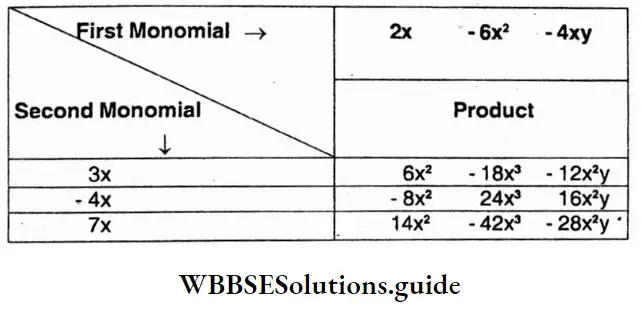
Algebraic Operations Exercise 6.10
Question 1. In each of the following cases, let’s multiply and find their product.
1. ab, (a2 – b2)
Solution:
ab, (a2 – b2) = ab x (a2 – b2)
= ab3 – ab3
2. 4a, (a + b – c)
Solution :
4a, (a + b – c)= 4a × (a + b – c)
= 4a2 + 4ab – 4ac
3. 6a2b2, (2a + b)
Solution :
6a2b2, (2a + b) = 6a2b2 × (2a + b)
= 12a3b2 + 6a2b3 (Ans.)
4. xyz, (x2y – y2x + z2y)
Solution :
xyz, (x2y – y2x + z2y) = xyz x (x2y – y2x + z2y)
= x3y2z – x2y3z + xy2z3
5. 0, (ab + bc – ca)
Solution :
0, (ab + bc – ca) = 0 x (ab + be + ca)
= 0
Question 2. Let’s simplify
1. 7x (2x + 3) – 5x (3x – 4)
Solution :
7x (2x + 3) – 5x (3x – 4) = 7x (2x + 3) – 5x (3x – 4)
= (14x2 + 21 x) – (1 5x2 – 20x)
= 1 4x2 + 21 x – 1 5x2 + 20xy
= 14x2 – 15x2 + 21 x + 20x
= – x2 + 41x
2. x(x – y) + y (y – z) + z (z – x)
Solution :
x(x – y) + y (y – z) + z (z – x) = x2 – xy +y2 – yz + z2 – zx
= x2 + y2 + z2 – xy – yz – zx
3. 2x – 6x (5 – 8x – 3y)
Solution :
2x – 6x (5 – 8x – 3y) = 2x – 30x + 48x2 + 18xy
= 48x2 + 18xy – 28x
4. 7a – 2 (5a + 6b – 7)
Solution:
7a – 2 (5a + 6b – 7) = 7a – 10a – 12b + 14
= 14 -7a -12b.
WBBSE Class 7 Math Solution Algebraic Operations Exercise 6.11
Question 1. Let’s multiply :
1. (10 – 3x) (7 + x)
Solution :
(10 – 3x) (7 + x) = 10 (7 + x) – 3x (7 + x)
= 70 + 10x – 21x – 3x2
= – 3x2 – 1 1x + 70
2. (11 +2x) (8 – 2y)
Solution :
(11 + 2x) (8 – 2y) = (11+ 2x) × (8 – 2y)
= 11 (8 – 2y) + 2x (8 – 2y)
= 88 – 22y + 1 6x – 4xy
3. (a + by) (4a – 6y)
Solution :
(a + by) (4a – 6y) = (a + by) × (4a – 6y)
= a (4a – 6y) + by (4a – 6y)
= 4a2 – 6ay + 4aby – 6by2
4. (2x2 y – y2 ) (3x-5y)
Solution :
(2x2 y – y2 ) (3x – 5y) = (2x2 y – y2 ) × (3 -5y)
= 2x2 y (3x – 5y) – y2 (3x – 5y)
= 6x3 y – 1 0x2 y2 – 3xy2 + by3
5. \(\left(\frac{x}{2}-\frac{y}{3}\right)\left(\frac{2 x}{3}-\frac{3 y}{5}\right)\)
Solution:
⇒ \(\left(\frac{x}{2}-\frac{y}{3}\right)\left(\frac{2 x}{3}-\frac{3 y}{5}\right)=\left(\frac{x}{2}-\frac{y}{3}\right) \times\left(\frac{2 x}{3}-\frac{3 y}{5}\right)\)
= \(\frac{x}{2}\left(\frac{2 x}{3}-\frac{3 y}{5}\right)-\frac{y}{3}\left(\frac{2 x}{3}-\frac{3 y}{5}\right)\)
= \(\frac{x^2}{3}-\frac{3 x y}{10}-\frac{2 x y}{9}+\frac{y^2}{5}\)
= \(\frac{x^3}{3}-\frac{47 x y}{90}+\frac{y^2}{5}\)
6. \(\left(\frac{2 a^2}{7}-\frac{1}{5}\right)\left(\frac{3 a}{5}-\frac{2}{9}\right)\)
Solution:
⇒ \(\frac{2 a^2}{7}\left(\frac{3 a}{5}-\frac{2}{9}\right)-\frac{1}{5}\left(\frac{3 a}{5}-\frac{2}{9}\right)\)
= \(\frac{6 a^3}{35}-\frac{4 a^2}{63}-\frac{3 a}{25}+\frac{2}{45}\)
Algebraic Operations Exercise 6.12
1. Let’s find values of the following mentally
1. 3a × 4b
Solution:
3a × 4b = 12ab
2. 12ab ÷ 3a
Solution:
12ab ÷ 3a = 4b
3. 12ab ÷ 3
Solution:
12ab ÷ 3 = 4ab or, 12ab ÷ 4ab = 3
4. (-x2 ) × x
Solution:
(-x2 ) × x = – x3
5. 9x2 – 3x2
Solution:
9x2 – 3x2 = 3
6. x2 × x2
Solution:
x2 × x2 = x4
7. \(x^2 \times \frac{1}{x^2}\)
Solution:
\(x^2 \times \frac{1}{x^2}\)= 1
8. 0 ÷ ab = 0
Solution:
0 ÷ ab = 0
9. 4a2b2c2 × 0
Solution:
4a2b2c2 × 0 = 0
10. 3ab + 3b
Solution:
3ab + 3b = a or, = 3ab ÷ a = 3b.
11. x0 xy
Solution:
x0 xy = 1 xy
= y
12. x÷ 0
Solution:
x÷ 0 =.undefined.
Question 2. Let’s multiply
1. 2x2 × (-3y) x 6z
Solution :
2x2 × (-3y)× 6z = – 36x2yz
2. 7xy2 × 8x2y × xy
Solution :
7xy2 × 8x2y × xy= 56x4y4
3. (- 3a2) × (4a2b) × (-2)
Solution:
(- 3a2) × (4a2b) × (-2) = 24a4b
4. \((-2 m n) \times \frac{1}{6} m^2 n^2 \times 13 m^4 n^4\)
Solution:
\((-2 m n) \times \frac{1}{6} m^2 n^2 \times 13 m^4 n^4\) = \((-2) \times \frac{1}{6} \times 13 m^{1+2+4} n^{1+2+4}\)
= \(\frac{13}{3} m^7 n^7\)
5. \(\frac{2}{3} x^2 y \times \frac{3}{5} x y^2\)
Solution:
\(\frac{2}{3} x^2 y \times \frac{3}{5} x y^2\)
= \(\frac{2}{3} x \frac{3}{5} x^{2-1} y^{1+2}\)
= \(\frac{2}{5} x^3 y^3\)
6. \(\left(-\frac{18}{5} x^2 z\right) \times\left(-\frac{25}{6} x z^2 y\right)\)
Solution:
⇒ \(\left(-\frac{18}{5} x^2 z\right) \times\left(-\frac{25}{6} x z^2 y\right)\)
= \(\frac{18}{5} \times \frac{25}{6} x^{2+1} z^{1+2} y\)
= 15 x3z3y
7. \(\left(-\frac{3}{5} \mathrm{~s}^2 \mathrm{t}\right) \times\left(\frac{15}{7} \mathrm{st}^2 \mathrm{u}\right) \times\left(\frac{7}{9} \mathrm{su}^2\right)\)
⇒ \(\left(-\frac{3}{5} \mathrm{~s}^2 \mathrm{t}\right) \times\left(\frac{15}{7} \mathrm{st}^2 \mathrm{u}\right) \times\left(\frac{7}{9} \mathrm{su}^2\right)\)
= \(-\frac{3}{5} \times \frac{15}{7} \times \frac{7}{9} s^{2+1+1} t^{1+2} u^{1+2}\)
= – s4t3u3
8. \(\left(\frac{4}{3} x^2 y z\right) \times\left(\frac{1}{3} y^2 z x\right) \times\left(-6 x y z^2\right)\)
Solution:
⇒ \(\left(\frac{4}{3} x^2 y z\right) \times\left(\frac{1}{3} y^2 z x\right) \times\left(-6 x y z^2\right)\)
= \(-\frac{4}{3} \times \frac{1}{3} \times 6 x^{2+1+1} y^{1+2+1} z^{1+1+2}\)
= – \(\frac{8}{3} x^4 y^4 z^4\)
9. 4a (3a + 7b)
Solution :
4a (3a + 7b) = 12a2 + 28ab
10. 8a2 × (2a + 5b)
Solution :
8a2 × (2a + 5b)= 8a2 × 2a+ 8a2 x 5b
= 16 a3 + 40 a2b
11. – 1 7 x2 × (3x – 4)
Solution :
– 1 7 x2 × (3x – 4) = – 17x2 × 3x – 17 x2 (-4)
= – 51x3 + 68x2
12. \(\frac{2}{3} a b c\left(a^2+b^2-3 c^2\right)\)
Solution:
⇒ \(\frac{2}{3} a b c\left(a^2+b^2-3 c^2\right)\)
= \(\frac{2}{3} a b c \times a^2+\frac{2}{3} a b c \times b^2+\frac{2}{3} a b c\left(-3 c^2\right)\)
= \(\frac{2}{3} a^3 b c+\frac{2}{3} a b^3 c-2 a b c^3\)
13. 2 × 5x (10x2y – 100xy2)
Solution :
2 × 5x (10x2y – 100xy2) = 10x x (10x2y – 100xy2)
= 100x3y – 1000x2y2
14. (2x + 3y) (5x-y)
Solution :
(2x + 3y) (5x-y) = 2x (& – y) + 3y (5x – y)
= 10x2– 2xy + 15xy – 3y2
= 10 x2 + 13xy – 3y2
15. (a2 – b2) (2b – 6a)
Solution :
(a2 – b2) (2b – 6a) = a2 (2b2– 6a) – b2 (2b – 6a)
= 2a2b – 6a3 – 2b3 + 6ab2
16. (x + 2.) (3x + 1 )
Solution :
(x + 2.) (3x + 1 ) = x (3x + 1 ) + 2 (3x + 1 )
= 3x2 + x + 6x + 2
= 3x2 + 7x + 2
Question 3.
1. Seema planted 3x saplings in a row, In 2x such rows let’s find how many saplings Seema can plant.
Solution :
In each row, Seema planted 3x saplings
∴ In 2x rows she will plant = 3x × 2x = 6x2 saplings
2. The length of a rectangle is (4x + 1 ) m and its breadth is 3zm. Let’s calculate the area of the rectangle.
Solution :
Length & Breadth of the rectangle are (4x + 1 ) m & 3x m
∴ Area of the rectangle = (4x + 1) × 3x sqm
= (12x2+3x) sqm.
3. Presently, the price of a dozen of bananas has increased by Rs. 6. If the previous price of a dozen of bananas was Rs. x, let’s find the cost of 2x dozen of bananas.
Solution :
Previously the price of one dozen banana was Rs. x.
Present price of one dozen banana is Rs. (x + 6)
Price of 2x dozen banana is Rs. (x + 6) × 2x
= Rs. (2x2 + 12x).
4. Let’s find the area of a square whose each sode is 7x cm.
Solution :
Area of a square whose each side is 7x cm.
= 7x × 7x sqcm
= 49x2 sqcm
5. The area of a rectangle is 8x2 sq units. If its length is 4x units, let’s find its breadth.
Solution:
The area of rectangle = 8x2 sq unit
And its length = 4x unit
The breadth of the rectangle = (8x2 ÷ 4x) unit
= 2x unit
6. Sushobhan sold 729y4 number of kites in 9y days. Let’s find the number of kites sold in average per day.
Solution:
Susobhan sold in 9y day 729 y4 kites
∴ He sold in 1 day = \(\frac{729 y^4}{9 y}\) kites
= 81 y3 kites
4. Let’s divide the first algebraic expression by the second algebraic expression in the following pairs of algebraic numbers
1. 8x3b, x2b
Solution :
= 8x3b ÷ x2b
= \(\frac{8 x^3 b}{x^2 b}\)
= 8x
2. 9xy3, xy
Solution:
9xy3, xy = – 9xy3 xy
= \(\frac{-9 x y^3}{x y}\)
= -9y2
3. -15xYz2,-x2yz2
Solution :
-15xyz2,-x2yz2= (- 1 5x2y4z2) -4- (- x2yz2)
= \(\frac{-15 x^2 y^4 z^2}{-x^2 y z^2}=15 y^3\)
4. 21 l3m3n3, – 4l4mn
Solution:
21 l3m3n3, – 4l4mn = (21 l3m3n3) ÷ (4l4mn)
= \(\frac{\left.21\right|^3 m^3 n^3}{-\left.4\right|^4 m n}\)
= \(-\frac{21}{4l} m^2 n^2\)
2. (5a2 – 7ab2), a
Solution : = (5a2 – 7ab2) ÷ a
= \(\frac{5 a^2}{a}-\frac{7 a b^2}{a}\)
= \(5 a-7 b^2\)
6. (- 48x9 + 12x6), 3x3
Solution :
(- 48x9 + 12x6), 3x3 = (- 48x9 + 1 2x6) ÷3x3
= \(\frac{-48 x^9}{3 x^3}+\frac{12 x^6}{3 x^3}\)
= – 16 x6 + 4x3
7. 15m2n + 20m2n2, 5mn
Solution:
15m2n + 20m2n2, 5mn = (15m2n + 20m2n2) ÷ (5mn)
= \(\frac{15 m^2 n}{5 m n}+\frac{20 m^2 n^2}{5 m n}\)
= 3m + 4mn
8. 36a5b2 – 24a2b5, – 4a2b2
Solution:
36a5b2 – 24a2b5, – 4a2b2 = (36a5b2 – 24a2b5) ÷ (-4a2b2)
= \(\frac{36 a^5 b^2}{-4 a^2 b^2}-\frac{24 a^2 b^5}{-4 a^2 b^2}\)
9. 3pqr + 6p2qr2 – 9p3q2r3, – 3pqr
Solution :
3pqr + 6p2qr2 – 9p3q2r3, – 3pqr = (3pqr + 6p2qr2 – 9p3q2r3) ÷(- 3pqr)
= \(\frac{3 p q r}{-3 p q r}+\frac{6 p^2 q r^2}{-3 p q r}-\frac{9 p^3 q^2 r^3}{-3 p q r}\)
= – 1 – 2pr + 322qr2
10. m2n4 + m3n3 – m4n2, – m4n4
Solution :
m2n4 + m3n3 – m4n2, – m4n4 = (m2n4 + m3n3 – m4n2) ÷ (m4n4)
= \(\frac{m^2 n^4}{-m^4 n^4}+\frac{m^3 n^3}{-m^4 n^4}-\frac{m^4 n^4}{-m^4 n^4}\)
= \(-\frac{1}{m^2}-\frac{1}{m n}+\frac{1}{n^2}\)
5. Let us simplify the following –
1. a (b – c) + b (c – a) + c (a – b)
Solution :
a (b – c) + b (c – a) + c (a – b) a (b – c) + b (c – a) + c (a – b) = ab -ac +bc – ab + ac – bc
= 0
2. a (b – c) – b (c – a) – c (a – b)
Solution :
a (b – c) – b (c – a) – c (a – b) = ab – ac – bc + ab – ac + bc
= 2ab – 2ac .
3. x (x + 4) + 2x (x – 3) – 3x2
Solution :
x (x + 4) + 2x (x – 3) – 3x2 = x2 + 4x + 2x2 – 6x2 – 3x
= x2 – 2x – 3x2 + 4x – 6x = – 2x
4. 3x2 + x (x + 2) – 3x (2x + 1 )
Solution :
3x2 + x (x + 2) – 3x (2x + 1 ) = 3x2 + x2 + 2x – 6x2 – 3x
= 4x2 – 6x2 + 2x – 3x = – 2x2 – x
5. (a + b) (a – b) + (b + c) (b – c) + (c + a) (c – a)
.Solution :
(a + b) (a – b) + (b + c) (b – c) + (c + a) (c a)
= a(a – b) + b(a – b) + b(b – c) + c(b – c) + c(c – a) + a (c – a)
= a2 – ab + ab – b2 + b2 – bc + bc – c2 + c2 – ac + ac – a2
= 0
6. (a2 + b2) (a2 – b2) + (b2 + c2) (b2 – c2) + (c2 + a2) (c2 – a2)
Solution :
(a2 + b2) (a2 – b2) + (b2 + c2) (b2 – c2) + (c2 + a2) (c2 – a2)
= a2 (a2 – b2) + b2 (a2 – b2) + b2 (b2 – c2) + c2 (b2 – c2) + c2 (c2 – a2) + a2 (c2 – a2)
= a4 – a2b2 + a2b2 – b4 + b4 – b2c2 + b2c2 – c4 + c4 – a2c2 + a2c2 – a4
= 0
